MiG-21 in Afghanistan
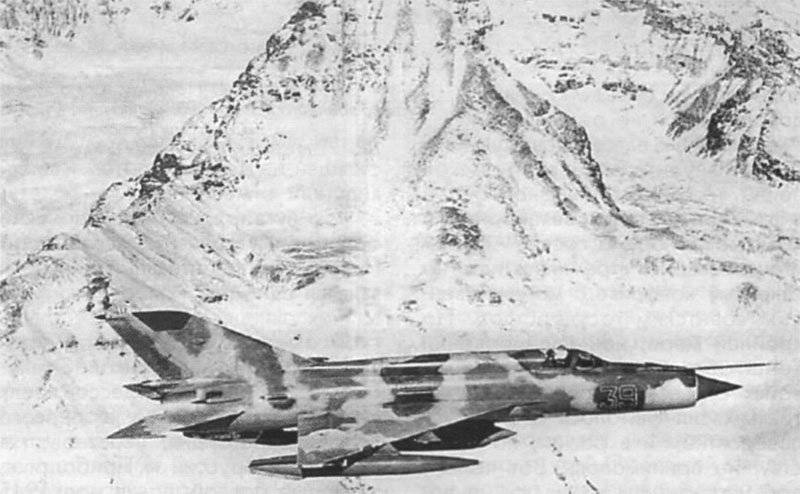
Taking into account these predictions, an operation was being built to "assist the people of Afghanistan in the fight against external aggression." For air cover, an anti-aircraft missile brigade was deployed to the 40 Army, and at first, one MiG-21 squadron from fighter and fighter-bombing aircraft flew to DRA airfields. The fighters belonged to the 115 of Guards. Iap, based at the Kokayta Turkmen airfield, commanded by Lieutenant Colonel P.I. Nikolaev Their fellow fighter-bombers were from 136-th apib from Chirchik in Uzbekistan. The leadership at the army level was carried out by Colonel V.P. Shpak, Deputy Commander of Aviation of the 40 Army for Frontal Aviation.
It was supposed to be managed by relatively small forces, limiting itself to attracting local aviation units from the forces that were in the Turkestan and Central Asian military districts (TurkVO and SAVO), and therefore the transfer was carried out from nearby airfields (Kokayts, what is called, lay just over the mountain, only fifty kilometers away from the border). What the operation would result in was not yet imagined and hoped to get by with the forces of the nearest units. The same applied to the entire 40 Army, completed on the basis of the cropped units of the southern districts, with the exception of the airborne units assigned to it from the airborne forces. But just in case, other parts of the Air Force and Air Defense, up to the most remote military districts, were also brought to increased combat readiness.
At first, attracted aviation was concentrated as part of the 34-th mixed air corps, formed from parts of TurkVO and attached to a grouping of Soviet troops heading for Afghanistan.
When troops were sent to Afghanistan, an attack could be expected primarily from the southern direction, from where planes could break from aircraft carriers of the American 7th fleet, and from the Pakistani side, which at that time had more than 200 military aircraft. The border with Iran, embraced by the anti-Shah revolution and occupied with its own problems, was considered relatively safe. Without a doubt, the military leadership in planning events fairly soberly assessed the situation and had no illusions about the persuasiveness of such propaganda "horror stories" - later the chief of the General Staff N.V. Ogarkov spoke of these arguments of politicians as "an invention of an implausible and not very smart." The Americans, who had barely recovered from the exhausting Vietnam war, then could not have dreamed of getting involved in a new adventure, and the neighbors of Afghanistan did not at all seek an open conflict with the powerful Soviet state. At least, when the General Staff planned the operation to send troops, serious opposition from third forces was considered extremely unlikely and, in essence, was not taken into account. That is why the entire fighter group at the initial stage was considered possible to be limited to one squadron.
Meanwhile, if the threat of aggression from outside was real, which would have endangered the adjacent Soviet territory, there would clearly not be enough to securely cover the airspace of Afghanistan. To repel enemy air hordes in the Afghan direction, according to all estimates, it was necessary to employ at least six fighter regiments. However, such an event was not planned for implementation either during the deployment of troops, or at the height of the Afghan campaign, and the fighter forces in the 40 Army aviation were brought only to a regular regiment, and then with time.
Soon, in connection with the reform of the Air Force and Air Defense conducted since the beginning of 1980, in accordance with which the former structures were replaced by the air forces of the districts subordinated to the general military command, the 34-th SAK was transformed into the 40-th Air Force. Thus, the 40 army became the only one in the Soviet Armed Forces, which had its own aircraft. The decision turned out to be fully justified and confirmed its effectiveness (in contrast to the transfer of military aviation to the subordination of districts in the Union, which was conceived in a similar way, which had become an unsuccessful experience and subsequently canceled).
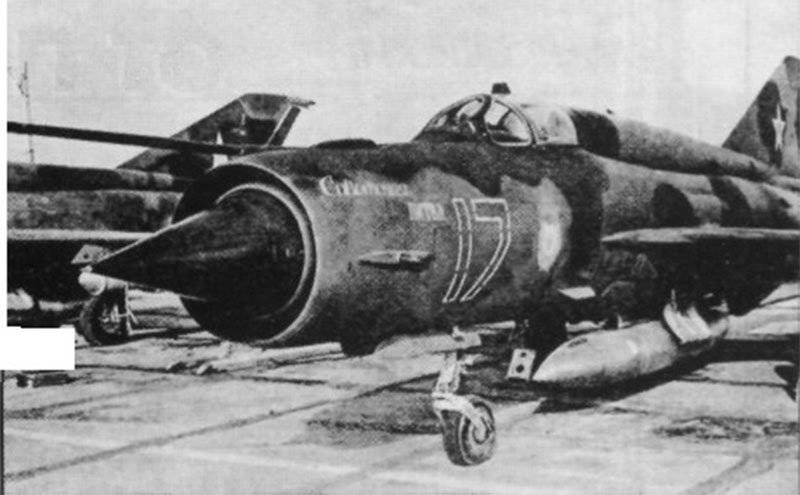
The 115 Guards Orshansky Order of Kutuzov and Alexander Nevsky Fighter Wing was one of the most titled aviation units of Soviet aviation. Being formed on the eve of the Great Patriotic War near Odessa, the regiment with honor went through the war from the first to the last day, participated in the battles in Belarus and the Baltic States, completing the military path in May 1945 of the year in Czechoslovakia. In memory of the military merit, one of the squadrons of the regiment carried the honorary title "Moscow", the other was called "Soviet Lithuania". However, the involvement of the regiment to participate in the Afghan campaign was dictated by no means former military achievements. Just to choose was, in fact, nothing out of which - the 115 th iap at that time was the only front-line aviation fighter aviation committee in all of TurkVO. Other forces here were represented by air defense interceptors, but their involvement in the air group was not envisaged.
When planning the transfer of aviation there was a problem of rational distribution of the available forces. There were only four airfields suitable for basing modern combat aircraft - Kabul, Bagram, Shindand and Kandahar. They were located at an altitude of 1500-2500 m above sea level. Approval of them deserved unless the excellent quality of the runway, especially the "concrete" of Kandahar and Bagram, laid by the Americans (the king Zahir-Shah, who was friends with the USSR, entrusted the development of the bases to Western experts).
The redeployment of the 115 th fighters was undertaken almost simultaneously with the commencement of the introduction of troops and the commencement of the landing of paratroopers in Kabul and Bagram. As soon as mid-day 27 December 1979, the airfields were taken under control, the 1-I squadron of the air regiment flew to Bagram. The squadron included 12 combat MiG-21 bis and two Sparky MiG-21UM. The paratroopers, who had occupied Bagram before the seizure of capital facilities, were all kept intact. The operation to seize the airfields was prepared with special care: the paratroopers were well oriented at night at the air base and quickly captured all the nodal structures; on the plans they had, even the arrangement of furniture in the rooms and the directions in which the entrance doors were opened were indicated. The engineering and technical staff, the control group and the necessary facilities were delivered by military transport aircraft, the regimental vehicles arrived a few days later on their own.
The headquarters of the 40 Army Aviation moved to a new duty station after the New Year, arriving in Kabul on January 9. The first aviation commander of the 40 Army was appointed Lieutenant-General Martynyuk, replaced by Major General B. Lepaev from February 2 in February 1980. Colonel G.V. became Deputy Commander of the Air Force 40 Army for Engineering Service. Yakunin, in whose engineering department Major V.P. was a leading MiG-21 specialist. Shilin himself flew the "twenty first". It was quickly discovered that the forces of a single fighter squadron were indispensable. On the Day of the Soviet Army 23 February 1980, the 2 squadron of the 115 regiment was also relocated to Bagram. From the end of March, the 1 squadron located here was transferred to the capital's airfield in Kabul, but was subsequently returned to Bagram again, leaving one link in Kabul to carry out the defense of the capital. In addition to the fighters, a reconnaissance squadron MiG-21Р and helicopters were deployed at the airfield, a field command and communication center was deployed. To strengthen the southern direction, the 2 squadron fighters have been stationed since May 1980 at the Kandahar airfield, located on the edge of the Registan desert.
The task of the fighters based in Bagram was to cover the central and eastern regions. Bagram represented a powerful military air base at 50 km north of Kabul, which looked impressive by domestic standards and was best suited to home fighter aircraft. The airdrome built under King Zahir-Shah served as the main base and training center for the Afghan Air Force: there were regiments of MiG-21 and Su-7BMK, which played a significant role in the days of the April revolution of 1978. The first-class solid cast concrete runway of Bagram had a length of 3300 m, and its width allowed the fighters to take off immediately by a link. True, navigation systems, communications, and even lighting were far from new, worn out, and did not meet the conditions of operation of modern aviation. At the sites were built powerful shelters for aircraft - these fortresses of boulders and stones, filled with concrete, equipped with shelters, communications and all necessary communications. Airplanes standing in them could be covered only with a direct hit. The airfield had a repair base, workshops, warehouses and storage facilities for fuel. His radio equipment and means of flight control, like everyone in the Afghan army, were of Soviet origin and were fully suitable for new "guests". The aircraft used by the Afghans was completely domestic, which made it possible to rely on the provision of repair and maintenance (if necessary, they could borrow spare parts and components from the Afghan colleagues to ensure the operation of the equipment). The proximity of Bagram to the USSR border simplified the supply - the air base with a large garrison was located at the highway linking Afghanistan with the Soviet Union and encircling the entire country.
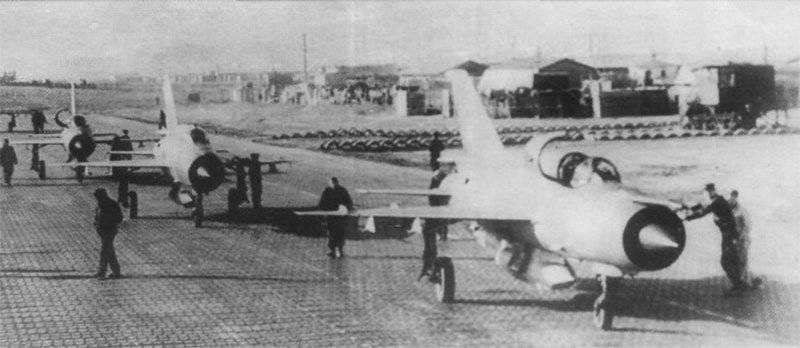
After at least a living garrison in the Union, the first impressions of the new duty station were not joyful. Captain V. Shevelev, who was among the first to arrive at Bagram, wrote: “They issued weapon, about the rest said - figure it out on the spot. Upon arrival, the first impressions came out of the planes: the mountains are incredibly close, there is a steppe around, and again mountains from all sides - a stone bag. On the tops of white bright snow, in sunny weather, even the eyes hurt. For some reason it was thought: beautiful, like on postcards. On the taxiing stands Mi-24 with a DShK bullet in the pilot's windshield. Wow. Everyone goes with guns. Nearby the dead were loaded into the plane. This did not add to the mood - it turns out that they are killing here.
I had to live in the hut up on the outskirts of the airfield, there was not enough space for all the arrivals. From the ceiling flows, from the cracks in the windows, clogged with plywood, whistling wind. The potbelly stove is warming while it is being inflated, it is slightly extinguished - it's cold again. At night time and again shooting, everyone wakes up, jump out, firing at lights at random.
When they moved to Kabul, it didn’t get any better - they lived in tents, cold, damp and mud everywhere. Barrel with water for dining and bathing dragged tank. From feeding, only porridge, dried potatoes and frozen pollock. The battalion commander announced that an additional ration was put on, but he was not there anyway, maybe, then he would be brought up As a little warmer, some biting midge began to annoy, they called her kukaracha. She has a fever from her bites, for three days she’s just breaking, shaking, the temperature is under forty, then a terrible weakness for another week.
Especially cold and dank at night, it is felt that the mountains are close. The winter is damp, often it snows in whole caps, we clean it off from one plane, while we coped with the other - on the cleaned one again the same amount. Afghan soldiers in the snow do not work, they sit at home in the warmth and warm themselves with tea. Only when the snow ceases to go, they go to the parking lot, considering that as warmer, the snow drifts from the airplanes. Towards evening, a very strong side wind always rises, flying is dangerous, blowing wildly, even skin cuts with sand and stones. "
The first winter, most aviators had to spend in tents and equipped in haste dugouts (as stated in the official papers: "with the use of personal tent-type tools, as well as mobile wagon-houses"). Even the engineering department of the 40 Army’s Air Force Headquarters did not have a better place than an earthen structure without a roof and windows. The allotted hut served both as a hostel and as a place of rest. To escape from the snow and freezing rain, the top had to pull the cover of the MiG-21. We slept on broken cots, hiding with overcoats, and a specially appointed duty officer watched the stove. For two weeks in a row they didn’t take off the overcoat, there was no place to wash clothes anyway. There was not enough electricity to provide machinery and life, power was supplied by mobile diesel generators, water was brought from local sources and newly drilled wells.
Settling themselves, the garrisons equipped stationary diesel power plants with a centralized power supply system, built boilers, water mains and sewage treatment plants. In place of the tents, entire townships with residential and service areas appeared. At the same time, as stated in the same documents, "a large amount of work on the construction of service-engineering buildings and barracks-dwelling towns is carried out by the forces deployed at the airfields". Over time, modular houses, office space and prefabricated hangars for vehicles appeared. The well-known Afghan modular houses were officially called “standard K-120 modular modular“ Module ”structures, the material for which was wooden and plywood panels on a metal frame with Wired and other household amenities. For the placement of headquarters, training bases and other service facilities were intended buildings such as CPM and other structures. The construction of such a structure required from two to four months (with a reservation about the "timely submission of building materials and structures," everything needed to be taken thousands of kilometers from the Union, and this despite the fact that the priority task of the transport workers was to ensure the actions of the army with fuel and ammunition. and by the way, and domestic problems were dealt with whenever possible). The output was an independent arrangement with the use of the only available material - bars from bombo-boards and boards from cartridge and shell boxes. Over time, entire quarters of the squatter settlement grew up in garrisons from khaki-colored boards. A few years later, these temporary buildings grew so much that the regiments that arrived to replace them met whole villages of bomb-houses, among which were even baths with saunas.
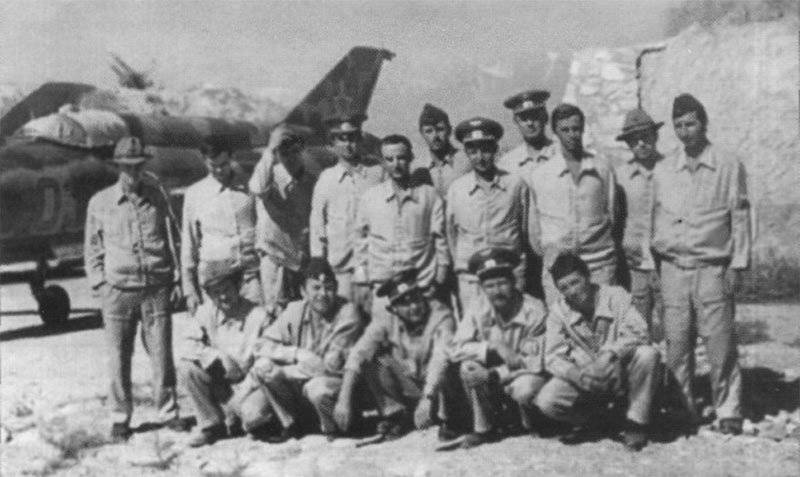
The fighter aviation group of the 40 Army at the first stage was represented by MiG-21bis aircraft - the last modification of the honored twenty-first, which was still in production by that time. By the time the Afghan campaign began, the MiG-21 was by no means the last word of technology, but in the front aviation of the southern districts then there was simply no more modern machines. Since the beginning of 70, fighter aircraft have been re-equipped with new MiG-23 aircraft, however, they were primarily sent to the “first line” in the western direction and to the Far Eastern fighter regiments on the extremely troubled border with China. The equipment of the aviation technology of the "rear" southern districts in previous years proceeded according to the residual principle.
In the 115 iap, there were two factory-made MiG-21bis airplanes of the 75 type: the 1 squadron flew on conventional equipment, and the 2 had airplanes with an additional set of RSBN short-range radio system as part of the landing equipment that interacts with ground vehicles azimuth-ranging radio beacons and course glide beacons. The use of modern equipment significantly increased the accuracy of navigation, simplifying navigation in the complicated conditions of Afghanistan and making it possible to carry out a descent and approach round-the-clock, even with limited instrument visibility. Entry by the instrumental method was allowed to the height of 50 m at any time of the day and in any weather conditions. Thus, the not-so-new “twenty-first” was far from providing the pilot with opportunities that even some more modern aircraft did not have. However, at first, part of the MiG equipment did not allow the use of the absence of the necessary systems on Afghan airfields - the Afghans with their far from new technology did not need such stations. Maintenance of the "bis" significantly simplified the implementation of the automated control system of the aircraft and the engine.
However, everything is relative. This old truth was visually illustrated by the Chirchik MiG-21PFM present in the neighborhood. Being far from the most modern aircraft in fighter aircraft, the MiG-21bis were much more advanced machines than the MiG-21PFM fighter-bombers. These aircraft had an age of over fifteen years, having lost their value as a fighter, because of which they were transferred to strike aircraft. But even with their service life, these airplanes still suited the service and the command considered that they could not be in a hurry to write off: they were quite suitable for bombing and firing at ground targets.
The Bisovsky modification with the serving MiG-21PFMs was separated for more than ten years, which was clearly demonstrated when comparing these similar “twins”. MiG-21bis was equipped with a new engine Р25-300, which gave out three and a half tons of greater maximum thrust, had more capacious tanks and qualitatively other equipment. Thereby, the increased thrust-to-weight ratio and fuel reserve significantly increased its bearing and take-off and landing qualities, however, the heavier "bis" began to lose in maneuverability. Nevertheless, the Mig-21bis exceeded all other “twenty-first” modifications in acceleration characteristics, take-off characteristics and climb. The takeoff run at the afterburner occupied only 830 m against 950 m from its predecessor (with thin air of highly located Afghan airfields, the required distance increased, but the length of the local runways was more than enough for takeoff, even with a normal combat load). The maximum vertical speed at the ground reached 235 m / s, surpassing even the similar qualities of the MiG-23, and the height of the practical 17800 ceiling m it gained in 9 minutes.
The most advantageous in the specific Afghan situation, which required actions in remote areas, looked like an increased range: with one front-bodied MiG-21bis outboard tank, the altitude had an 1480 km range with a flight duration of up to two hours. This turned out to be in demand and taking into account local features of navigation with a critical lack of landmarks and the monotony of the terrain (the mountains and deserts were, as they say, for one person, and the fuel supply was not superfluous). The benefit was also provided by the perfect navigation equipment of the “bis”, which allowed to feel confident in remote areas, to go to the place of combat work more reliably and precisely and to return to the airfield.
MiG-21bis significantly surpassed the predecessor also in the most important indicator for a combat vehicle, with great potential in terms of weight and arsenal of combat load. In MiG-21PF combat capabilities were limited to the suspension of only two bombs or rockets UB-16-57. "Bis" was equipped with a built-in gun GSH-23L and could carry weapons on four underwing holders, thanks to high thrust-to-weight and reinforced design having the ability to suspend one and a half tons of bombs: two "five hundred" on the inside nodes and two 250 kg on the outside. A set of weapons complemented the new types of weapons, including multi-lock bomb racks, which allowed to place on the suspension up to ten stokilogram caliber bombs, X-UMX-charging units UB-32 and other modern weapons. The use of weapons provided a new automatic sight, which allowed firing, including from a maneuver during overloads (the MiG-32PF was treated in the order that served as the collimator sighting device ASP-PF-21 of the "grandfather" sample). The result was a curious situation of a somewhat unexpected nature: the MiG-21bis, which was a “clean” fighter, looked like a much more sophisticated and powerful means of hitting ground targets, rather than representing the MiG-21PF strike aircraft. At the same time, ground-based attacks, bombing and shooting were not unusual for fighters: the current course of combat training of fighter aviation, practiced by the pilots, included relevant exercises, and after the necessary training they were not inferior to their colleagues.
The Bisa had its drawbacks: a feature of the heavier vehicle was an increased specific load on the wing: with normal take-off weight, this parameter reached 380 kg / m2 against 330 kg / m2 from its predecessor. The radius of the turn of the MiG-21bis on the ground exceeded one kilometer, which was one and a half times more than the Su-17 and MiG-23. This was a significant inconvenience when working on ground targets. Spreads on a large scale hampered the construction of combat maneuvers, and with repeated visits threatened with losing the goal that the pilot lost sight of at such distances. 15% difference in specific load was also manifested by perceived behavioral features at low speeds and rigor in management, which required coordination, especially during combat maneuvering. These features most directly affected the combat use of the aircraft. The presence of the autopilot, which monitored the behavior of the aircraft in terms of roll and pitch, which maintained the height of a given course and damped the oscillations of the aircraft, did not exclude the need for the pilot to pay attention to the behavior of the machine. Advantageous was the ability to use the coercion mode when, with loss of spatial orientation (for example, in the clouds or at night), turning on the autopilot allowed the aircraft to return to its normal position and hold it in the machine gun. The autopilot also enabled the use of the escape mode from a dangerous height, especially applicable in low-altitude flights or with loss of visibility of the ground.
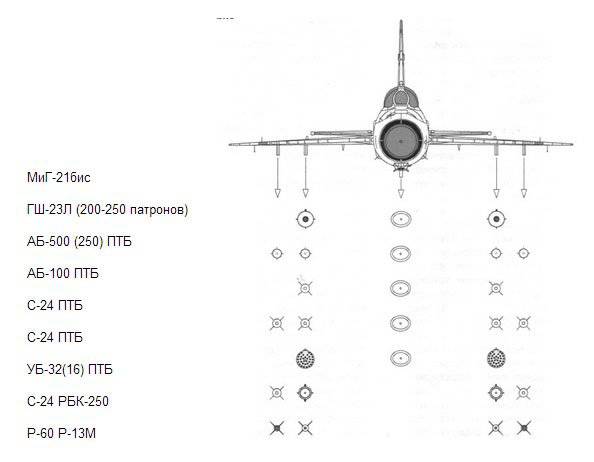
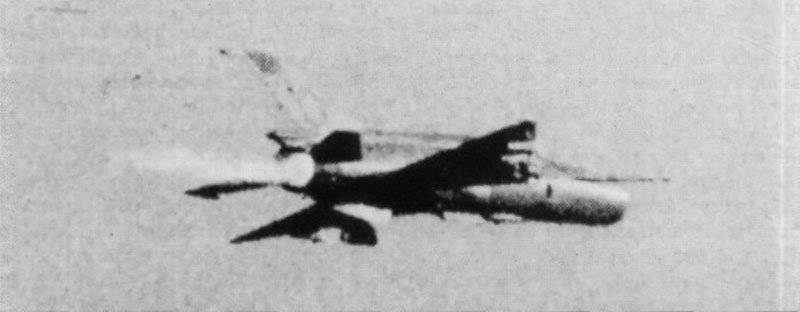
For the 136 aviators, participation in the Afghan events began when they were at their aerodrome. Soon after the April revolution in Kabul, the regiment was raised several times in alarm, in case of unforeseen developments, relocating to the Kokaity to the border itself, then for weeks keeping Mara next door to their local counterparts from 1978. The regimental commander, Colonel Viktor Sikorsky, himself remained unaware of the plans of the command (at least, it was not a question of sending him to Afghanistan). Nevertheless, bringing the regiment to increased combat readiness and a change of base position began to be worked out even two weeks before the events began. Another alarm was announced in the early morning of December 217 1. The following events were recalled by the flight commander Vyacheslav Tashtamyshev: “Having already been taught by experience, the pilots were not in a hurry. I packed up my suitcase, all the equipment, had breakfast and slowly went to the airfield. Everyone was not in transportation, they sat and waited. Many did not take anything necessary with them , even a toothbrush: they say, they will soon be dismissed home. Then it became known that the alarm was real and something was happening. Finally, the bus appeared and we went to the airfield. There they waited for the team again, but nobody set the task until it arrived commander declaring It was not surprising (the first time, perhaps?) to those who were left without personal belongings, it was strictly indicated with the use of intelligible expressions that the matter was serious and ordered to go to the town to get things. Flight preparation was the easiest: they set up a radio compass, they drew a route on a pencil map — a straight line, set the distance, course and time from the navigator of the regiment, and all the navigation calculations ended there. No ammunition was hanged, even the PTB was not taken, no one knew that we were going to war. After the flight, two weeks lived on a traveling position without any specificity. There was no flight or theoretical training for combat use, so we flew a little to preserve skills.
Everything changed in the most unexpected way of December 25: we were "cut" into several alert zones over Afghanistan, where we had to work in the following days. At this very time, the troops went to Afghanistan, crossing the border Amu-Darya. One zone was located west of Mazar-i-Sharif near the road, the other had the eastern border of Tashkurgan, between them was the road to Kabul. Another zone extended north of Tashkurgan. There were sent one pair of aircraft with the PTB-490 and the pair of C-5 units. The task was set in the most general way: "... Stay in the zone, if an aeronautical engineer gets in touch with you, by his commands strike a blow to this and that". Before, we did not work this way, and vaguely imagined how it would all happen. After all, even the columns of troops that went along the roads were not visible from the designated zones. Before the departures, an infantry chief arrived who said that the Afghan air defense system is still unknown on whose side and in the Mazar-i-Sharif area they have anti-aircraft missiles, so anything can happen and therefore it should be monitored for possible missile launches. Intimidated by this, so it was not clear what to watch out for — a likely opponent or anti-aircraft gunners. In one of the December 26 departures downstairs, a small airplane took off from a small aerodromchik north of Mazar-i-Sharif. Gazuya, he raised a cloud of dust - seemingly exactly launching a rocket. With a frightened pair with the slave, we began to turn anti-missile maneuvers, dodging the impact. It seems to be nonsense, but from unaccustomed fear suffered.
The invasion itself did not look like a parade either. There were no slender columns of brave warriors and a chased stride. They recruited through the military registration and enlistment offices from the reserve of reservists in Turkmenistan, Uzbekistan: those who served urgent, sometimes they were already over forty years old. We saw them every day in the city, in overcoats from military stocks, unshaven, with worn out Sidor-knapsacks, PCA and other military antiques. There was no talk about military training. They picked cotton, and they were straight from the fields to the war. Machines were completely unaccompanied by armored vehicles. These columns we were supposed to cover. We did this until the New Year. It was already cold, because they flew in some flight overalls and leather jackets, that they would need winter clothing, no one took care to warn. Some special equipment was also missing. With him - only the unfortunate Makarov pistol, two clips in his pockets and two more - under the seat in the NazE. On other planes he was sorted out, adjusting for the installation of the machine gun and a decent supply of ammunition, but on the MiG-21 it never came to that. Later, they began to issue a Stechkin pistol to the APS, which can shoot in bursts, but it did not fit on a belt and had to be hung on a harness around the neck. In flight, he was very disturbed, so he was often left when he was flying home under a pillow. They gave two more grenades, but they tore their pockets in overalls, and without that shabby, and they were also left at home. There was no camouflage then and there was no mention: who flew in what - in blue, sand or blue overalls. Then they didn’t know that in case of fire their fabric melts and burns to the skin (thank God, there was no experience).
We were engaged in such departures in zones and on duty at the aerodrome until the end of December and another week after the New Year. They covered themselves, flew, but there was no real enemy. There were no combat training exercises either; we didn’t shoot and didn’t fly to the training ground. Flight bookings were recorded not as combat flights, but passing through the course of combat training to a class. Then, according to the flight book, it wasn’t to establish which flights were over their territory and which were over the DRA. I had to guess: apparently, if a flight was recorded for interception, then this is probably purely training, and if the exercises were performed by a pair or by a link, then surely “beyond the river”. The fathers-commanders themselves did not really treat the task as a combat one. Once the war was not declared out loud, then it was necessary to be engaged in the assigned tasks - planned preparation and confirmation of the qualifications of the flight personnel. So we thought not only alone. Probably, those who made the decision and gave the command: they say, everything will go without shooting and there will be no war: the troops will enter, scare the disgruntled, help the new correct government to establish itself, and the deed will be done. But it turned out wrong ...
9 January covered another column from Termez on Faizabad. It was a motorized rifle regiment, with trucks and equipment, with armor covered from the head and tail. The column passed Talukan and headed towards Kishim. Stretching out, the column formed a gap of a kilometer, where there was neither “armor” nor fire weapons. There the rebels struck. They then knew how to fight, even though they looked wildly - on horseback, with antediluvian Berdank. Losses in the column were very large. Aviation was called for help.
From our Chirchik regiment, we were the first to raise a pair of flight commander, Captain Alexander Mukhin, who was in readiness No. 1 from his plane. Behind him flew a group of leadership. Excitement was great, everyone wanted to make war, to be noted in the case. On returning, the commanders immediately changed the plane, transferring to the trained fighters waiting. The rest had to be content with sitting in the cabs in readiness, waiting for the queue. The pilots flew excited, told just like in the movie about Chapaev: they shot at NURS from the UB-32 units at a crowd of cavalry and foot dushmans, practically in open areas. Then they chopped decently.
In early January, the first squadron led by the regiment commander lieutenant colonel V.P. Monakhov was sent to reinforce the 40 Army air force, transferring to Kandahar in southern Afghanistan. The second was returned home to Chirchik to relearn a newer plane - the MiG-21CM. And our third left in Kokayty, to continue work in the north of Afghanistan. But stay there did not last long, less than a month. Exactly on the eve of the Day of the Soviet Army 23 February was preparing for the celebration. And only we went to the bazaar for purchases, as the commander’s gas driver and commander Zuzlov appear on the market with terrible eyes: “Run to the car, fly to Bagram!”. Everyone was surprised: "Commander, look at the sky - what kind of Bagram in this weather?". "Hurry, this is a combat order, execute immediately, otherwise the tribunal!". We barely had time to run into the room for toiletries, and on the planes. No one believed that we would fly - the weather was none, even for regular flights. And still heard the command to run. The first was a pair of komeska Zuzlov and the commander of the squadron of Major Sergey Fefelov, followed by the castle chief Major Alexander Bobkov and the senior pilot captain Ivan Ryzhkov. Bobkov had a launch failure and instead I was the one leading the pair. The entire squadron flew off to Bagram, and the table prepared for the holiday remained at home ...
Immediately after takeoff, they entered the clouds, the slaves lost their leaders. Only once in the lumen they saw each other and were again stuck in a continuous veil. It was not simpler at the train: they got into a strong jet current - this is a frequent phenomenon over the mountains - it was “blown away” noticeably, and there was no proper flight in the group yet. In addition, on the MiG-21PFM navigation is at the level of the children's designer, the whole set is a clock, a compass and a speed indicator. In a word, it drove us away from the line of a given path, it's great, there are so many kilometers ... so much. It would have turned out to be no where, but was rescued by KP Bagram. Found us, indicated the place. I had to turn on 90 ° and get to the exit on the route for another ten minutes. And the sun was shining above Bagram and there was one hundred percent visibility, as if as a reward for ordeals. "
By the beginning of January, the 1980, the MiG-21, formed the basis of the 40 Army Aviation: the 52 combat aircraft in Afghanistan at that time included the “twenty-first” 37: fighters, fighter-bombers and reconnaissance aircraft. Their share in the 40 Air Force remained predominant throughout the first year of the war.
The imperialists ’invasion of Afghanistan never took place, although propaganda did its work: many of the 1979 who happened to be in the DRA in December sincerely believed that they were ahead of the Americans just a few hours and even“ heard ”the roar of their aircraft! Perhaps the only "destructive" success of the first months was the interception of the Pakistani aircraft over Kabul. Pakistani went without communication out of schedule and aroused suspicion. A pair of MiG-21 bis climbed to intercept it and forced it to land at the capital's airfield. During the trial, it turned out that this was a passenger DC-8 and the intruder was released home.
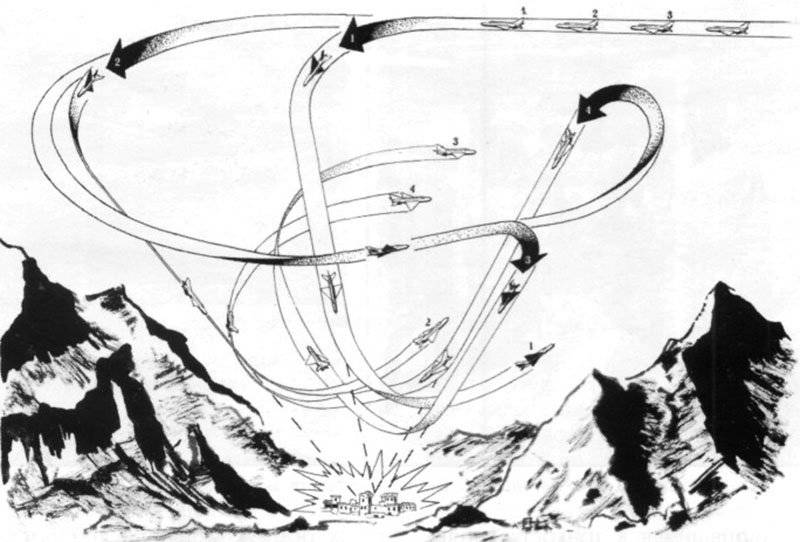
There was no enemy in the air, but very soon the fighters found another job. With the start of operations of the 40 Army, strikes against ground targets for a long time became the main occupation of fighter aircraft. Until the spring of 1980, the Soviet command tried not to conduct large-scale military operations. It was supposed to "mark" their presence in Afghanistan and put the Karmal government there, soon to withdraw the troops. But the "friendly Afghan people" turned out to be not very susceptible to the ideals of socialism, and the clumsy attempts to establish a "new life", often contradicting local customs and Sharia law, only multiplied the number of dissatisfied.
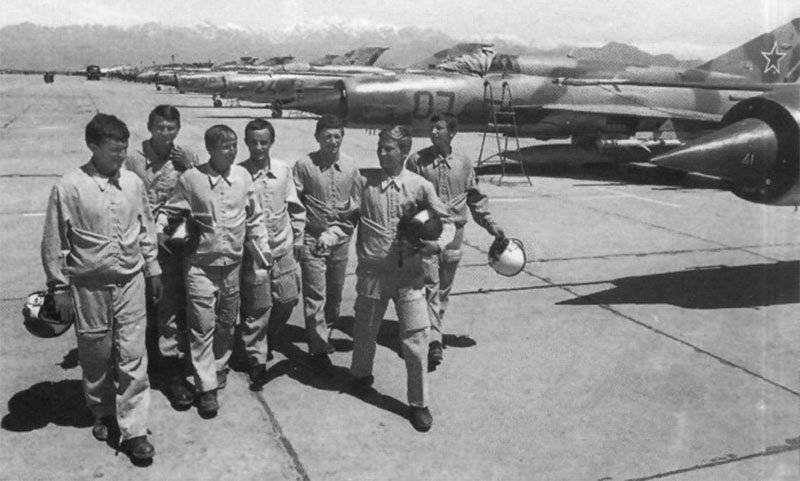
Residents of mountain villages, poorly versed in the intricacies of politics (many seriously believed that the Chinese had captured the Soviet Union, and therefore the Shuravi came to the Afghan land), was not accustomed to fighting for their freedom, and learned to use weapons from Pashtuns since childhood. They were dissatisfied with the new government in the army, preferring to join the rebels and fight the Kabul government with arms in their hands. One of the largest formations was a group of the subsequently known Turan Ismail, who had served in the army in the rank of captain and led armed resistance in the eastern provinces. Sometimes, whole units with armaments, and not only small ones, went over to the side of the rebels. Thus, the enemy received large-caliber machine guns, favored by the Mujahideen DShK and ZGU, mortars and recoilless guns. More powerful weapons in the mountain war were inconvenient and, even if armored vehicles and cannons (which required at least minimal training and maintenance) fell into the hands of trophies, did not use them and threw them when they changed the place of deployment of the detachment. In the south, a gang of Mohammed Hasan, who received military education in the USSR and had previously served in the officer ranks in the government army, operated near Ghazni. His detachments kept under control five surrounding gorges, having several dozen DShK and their artillery.
The need for the use of aviation arose in early January, literally a week after the MiGs arrived in Kabul.
There were no other combat vehicles in that part of Afghanistan at that time, and the fighters had to act as a universal means both to cover the airspace, and with the support of ground forces and reconnaissance. In early January, a mutiny occurred in the 4 artillery regiment of the Afghan army located in the city of Nakhrin in the north of the country. During the rebellion, Soviet military advisers stationed with the unit were killed. Having taken a military camp, the rebels dug in, built rubble on the roads and equipped artillery positions on the approaches. At the request of the Afghan authorities, Soviet units were brought in to disarm the rebel regiment. Since the enemy had real forces (he had artillery and was supported by local gangs), it was decided to knock out the most serious means out of his hands, for which purpose it was necessary to launch an air strike at the location of weapons stores and ammunition depots.
At first, they planned to use fighter-bombers from border airfields in the Soviet Union to launch a strike, but they could not find targets among the snow-covered foothills. Then, for the strike, the link MiG-21 from the 115 th regiment from Bagram, who had completed the bombing, was raised. Fighters were not involved in direct air support. The Soviet units advancing to Nakhrin escorted helicopters that dispersed the enemy from the air. The operation was carried out on January 9-10 with minimal losses, which amounted to two killed and two wounded.
MiG-21PFM from the squadron of 136-th apib was used literally on the move already on the day of arrival in Bagram. 22 February 1980, the captain Tomin’s link was attracted to strike in the area of Asmar, north-east of Jalalabad. The target was a fortress at the entrance to the Kunar Gorge. The planes were suspended by a pair of bombs FAB-250 and the ventral tank (although the target was at a distance of a hundred and fifty kilometers, after the flight they learned that the stock does not pull the pocket). They did not bomb the best way - the pilots admitted that bombing in the mountains still had to be learned. Departures to Kunar became the threshold of the upcoming military operation, where aviation was already used on a large scale.
In order to eliminate the centers of resistance to Soviet troops, at the end of February, an order was given: to begin active hostilities together with units of the Afghan army, primarily around the capital and in the areas bordering Pakistan. The first major operation was carried out in the province of Kunar in March 1980. The task was that the reinforced regiment was to pass north-east of Jalalabad along the Afghan-Pakistan border in the direction of Asadabad, where the government garrison was located. To the city stretched along the gorge of the river Kunar, the only road, mostly walking along the mountain cornices. The enemy’s troops were saddled along the road, and the city was blockaded the whole winter, to lift which, having adjusted the supply, was the main objective of the operation. At the same time, it was necessary to defeat the opposition forces, defiantly active in these places.
The advance of the Soviet motorized infantry regiment to Asadabad was supported by fighter-bombers (which caused the haste of their transfer to Bagram). The specifics of the Afghan conditions immediately manifested themselves: the advance of the troops was accompanied by continuous shelling, and the arriving pilots could not find the firing points hiding among the rocks and piles of stones - the high speed hampered, and the approach time (aviation was called on the radio) allowed the enemy to change positions. It was necessary to use obsolete maps that did not change from the 50-s, where even other cities and other settlements were called differently. The pilots, who knew that the targets should be somewhere here, had to strike the squares, covering the squares along the road. At the same time, several times they were getting to their troops from aviation fire; Fortunately, there were no casualties. The commander of the 108 Motorized Rifle Division, commander of the operation, was Colonel B.V. Gromov (later BV Gromov was twice assigned to Afghanistan, becoming the commander of the 40 army) described the first lessons in the use of aviation: “Aviation is a powerful force, but it must be controlled. There were air gunners in each column, but they They didn’t see and didn’t know where the fire was coming from. Therefore, at first we had to deliver air strikes on the squares, or give everything to the pilot — if he saw the enemy, then he bombed him with a bomb attack. Sometimes his troops fell under the fire of aviation. of that the high altitude it was difficult to make out where the spooks, and where our soldiers Two such cases occurred in front of me, however, there were no large loss of life -. it turned out that only equipment destroyed mostly, and sometimes beaten by. "
The 136 th apib fighter-bombers were regularly involved in work on the Panjshir, who served as a stronghold for Ahmad Shah's formations. In late February, the MiG-21PFM conducted reconnaissance of enemy targets in the gorge. Immediately the link of Captain Tashtamyshev needed to rise to work on the call. The customer was the artillery spotter who was at the top of the cliff, but the assignment of target designation to the aircraft was unfamiliar (we don’t understand their three-ten-left, two farther, fifteen ”teams), which led to the assistance of colleagues from army aviation . Helicopter pilots took up aiming at the target, indicating a place on the top of the slope just before the spotter post. The flight commander told about the attack:
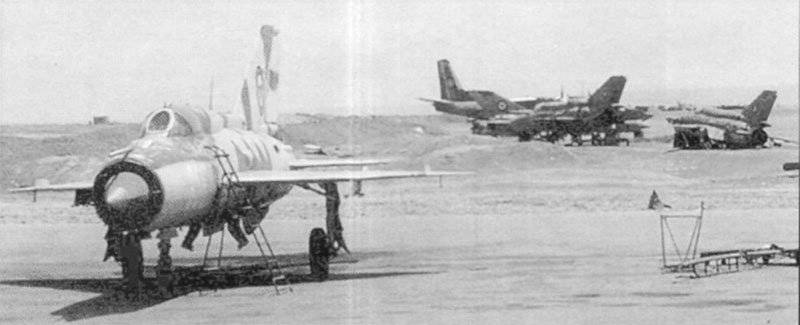
The main areas of intelligence of Bagram fighters were designated zones in Panjshir and the Kunar Gorge. When conducting reconnaissance, it was prescribed that, after detecting the objects causing doubts, it was necessary to first request a ground command post through the transponder aircraft and, after checking the situation, obtain permission to use weapons. Subsequently, such missions with independent detection of targets and their attack received the name of reconnaissance and percussion actions (RUD). At the first stage, however, they did not differ in efficiency: the search for mostly small and inconspicuous targets from the height and flight speeds of the fighters at 900 - 1000 km / h was not very effective, and there was almost no recognition of who was in the duval or village below possible. And without that, due to the lack of reliable landmarks, it happened during the flights to the Kunar to jump out of the border line. Sometimes such a violation was deliberate, being caused by the construction of a maneuver in the border area.
Sometime at the end of February, when searching for a fortress at Asadabad that served as a refuge to an enemy, the target was found right on the border line. On the map, its position looked quite obvious. In order to get a better look at the re-entry, I had to turn from the opposite direction, passing over the mountains from the Pakistani side. Such maneuvers did not arouse fears among the pilots - the Pakistanis showed restraint and, in the peaceful space until recently, their fighters were not on duty at the time.
In early March, the MiG-21PFM Chirchik squadron flew to Kabul. Their cars were the first combat aircraft in the capital's airport, where other aviation forces were represented by several helicopters. The arrival of the air transport group and several dozen helicopters as part of the 50-th mixed aviation regiment (sap) was being prepared, but the famous “fifty kopeck” later was just being formed at Soviet airfields. At the Kabul airport there were no parking areas for combat vehicles and the arriving squadron had to occupy a seat directly on the main taxiway, lined up with a Christmas tree along the concrete road, in plain sight by the passenger planes of the Afghan Bakhtar and neighboring eastern airlines. Objectives were assigned the same flights in the direction of the areas bordering Pakistan, but for the most part flew to explore over Kabul itself. The occasion was unrest and anti-Soviet speeches in the capital, when the Soviet embassy was shelled. The enemy openly showed intentions, and in order to regain control of the situation in Kabul, it was necessary to involve not only troops, but also aircraft, which looked like the most impressive argument. MiGs that rushed over the city made an impression with their own thunder and demonstration of power. Sometimes they flew at low and extremely low altitudes, where the altimeter was useless and was only careful not to dive under the wires (“what is called, they walked over their heads”). For convenience, the city was divided into sectors using maps of the largest scale. The task was set as follows: the couple on duty was raised, directing to the appropriate sector. Being over their sector, the pilots watched the situation, reporting on what was happening. If a gathering crowd was noted down below, they reported to the KP and took up the task of “restoring order”. Having lowered on extremely small height, passes over a collection ironed it. Few of the Afghans saw the plane at close range, so that the effect was achieved in the most awesome way: twisted roofs flew away, leaped into the air of a canopy of panels and flimsy adobe walls fell. It was impossible to withstand the shaking thunder and the whistle of rushing planes, and the public below ran away after one or two passes. The use of weapons of destruction was not required and was treated only by “pressure on the psyche”.
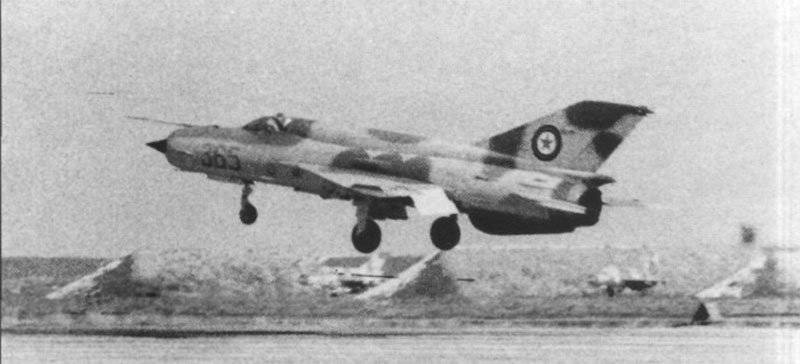
Such sorties were not counted as combat missions, and the very concept of combat sorties, not explicitly stipulated by the instructions, was interpreted by pilots differently. Some believed that any departure with ammunition is combat, regardless of whether the combat took place or not. Others objected that such can be considered only that in which the weapon was used, shot or bombed. As with the attitude to reconnaissance missions, there was no single opinion at all. Therefore, everyone tried to “check in” with shooting, confirming the title of a military pilot. In addition, there was a rumor that for 20 sorties (even if it is unclear what purpose) promised to present the order. Nobody had combat awards in the regiment, so the prospect sounded very tempting. Someone even in flight, at every opportunity, reported: "I see the target, allow me to attack." Upon his return, no one particularly tried to find out what kind of enemy he had met and what the results were when recording combat use. For all this time there was no combat damage on the MiG-21PFM.
The participation of the MiG-21PFM in the Afghan campaign was short-lived. The aircraft, which was in service since the 1963 year, to the beginning of the 80-s morally obsolete and had to give way to more modern technology. 13 March 1980, the squadron of the 136-th apib was withdrawn from Afghanistan, returning to the base of the unit in Chirchik. The houses of the pilots and technicians were waiting for retraining on the new MiG-21CM. The aircraft was a predecessor of the "bis". He was a representative of the previous generation - the cars that came to the regiment were released ten years ago and managed to serve in other regiments that replaced them with the newly received MiG-23. As a fighter-bomber, the MiG-21CM was slightly inferior to the encore due to its smaller fuel reserve, but it was lighter, had the same four suspension points and a similar range of weapons. Retraining for a similar type took just a few weeks, and since January, the pilots of two other squadrons based on the base had managed to master the MiG-21CM by this time and were involved in the formation of the group that was being sent to Afghanistan. In April-May, already two squadrons of the 40-th apib were sent to the 136-th Air Force, and in September, the third squadron left was sent after them.
One of the squadrons of 136-th apib was transferred to the airfield of Shindand - a tiny town in the desert near the Iranian border, where there was a large airfield with a strip of length 2940 m, which became the stronghold of the Soviet troops in these places. Shindand became the main location of the fighter-bomber aircraft - the Mi-21SM of the Chirchik regiment was replaced by Su-17, which had been redeployed when the troops were deployed. Another squadron 136-th apib deployed in Kandahar.
Shindand, Bagram, and Kandahar continued to remain the base airfields, between which, if necessary, the aircraft were transferred to concentrate powerful attack groups, serving as a kind of "land carrier", near which other parts were concentrated. The northern provinces DRA Balkh, Juzjan and Fariab, basically, "served" the MiG-21 from the Kokayta airfield, the pilots of which called the local gangs "their sponsors".
The stay of the MiG-21CM as part of the 40 Army's air force also did not drag out. These vehicles served in the 136 regiment for a little over a year, and they fought for a limited time, until an instruction was received to switch to a new and much more modern technique - Su-17МЗ fighter-bombers. Squadrons in turn began to return to the Union for retraining. The first 1981 winter went home to the 1 squadron, 2-I followed in February, and only the 3 squadron had to stay until the end of April.
However, the first loss of the 21 th apib is associated with the short-term exploitation of the MiG-136CM. In the course of retraining on the new 29 aircraft in January 1980, Senior Lieutenant Igor Kopyev crashed while returning to the airfield. Already on the way with the release of landing mechanization, the left flap came off, the plane instantly rolled over onto its back and crashed into the ground. At low altitude it was not possible either to bring the car or leave the plane, and the young pilot was killed. In the papers for some reason, there was a record of the death "when returning from a combat mission." In all likelihood, the occasion was the participation of the regiment at that time in the hostilities, which, however, young pilots with a lack of experience were not involved.
When setting targets, the 40 Army's Air Force Command did not make any special distinctions between fighter jets and fighter-bombers. There was enough work for everyone, and in terms of their skills, the fighters were not inferior to the IB pilots of aviation, getting the opportunity to test in practice the skills of bombing and ground attack, worked through the course of combat training of fighter aircraft. Bombing from a horizontal flight to the MiG-21 was useless due to the machine’s unsuitability for such work, and the main method of combat use was dive attacks. The calculation was built with approach from a safe height according to the conditions of the withdrawal, given the large subsidence of the aircraft at the exit of the dive in mountain conditions with significant elevations and thin air. It was also necessary to take into account the increased acceleration of the aircraft with a combat load during a steep dive, which was adjusted to 60 °, ensuring accurate laying of bombs.
Although the sighting equipment MiG-21bis, equipped only with a small sight, looked more modest compared to the sighting complexes of the latest modifications of the Su-17 and Su-25 with their calculators, laser range finders and Doppler radio systems, but in the mountains occupying 80% of Afghanistan and serving the main shelter of the enemy, sophisticated automatics gave many blunders, and the skills and individual techniques of the pilots who aimed at dropping bombs "at the tip of the PST." The effectiveness of strikes in the absence of familiar combat training goals (accumulations of military equipment, structures, missile positions and artillery) remained low.
Flying as a young lieutenant on MiG-21bis M. Pravdivets recalled his first combat mission: “In the spring of 1980, there were not enough pilots in the regiment and had to bring the squadrons in Afghanistan to a regular set by transfer from other parts. When I arrived in Afghanistan, I had no experience I wasn’t there. They explained that they would have to work more and more “on the ground", and we never even dropped the training bombs. The theory of bombing and piloting was unclear when it hit. After all, I knew something, after all school with red di I ended up with a crowbar, but there were no skills. Such "asas" strengthened the combat squadrons. After several training flights, the komesk turned me into a battle pair. It was necessary to strike in Parminskiy gorge next to Bagram (later we called him "diamond gorge", there everywhere there were placers of precious stones.) The loading of the aircraft was four OFAB-250-270 bombs. The attack had to be carried out according to the instructions of the aircraft manufacturer, the target was firing points on the mountain slopes.
After setting the task, I asked the commander: "How do you drop bombs?" He explained to me that the main thing is to keep order and look at him. As soon as his bombs are gone, then I will be thrown off with a delay "and r-time ..." because from the first approach and in the first attack in my life I still won’t find where to aim, especially since we must put on the "alleged" firing points. And the delay is needed for the bombs to form with dispersion: it makes no sense to put all eight pieces in one place, let these two tons cover a large area, so it’s safer.
Departure was performed 8 August in the early morning. We took off with the dawn while it was cooler, otherwise taking off in the summer in the heat of the day with four pendants is very difficult. The plane with four bombs really ran an unusually long time. Above the site contacted the gunner, he suggested landmarks and the slope on which to work. In the gorge in the early morning it was still dark. Following the lead dive somewhere in the dark. He got the "drops", I also press on the dump. For the first time in my life I heard the plane flinch at the time of the bomb drop. Conclusion. The gunner says where the breaks are and corrects. Switched to the internal suspension and made another sunset. Reset again. Conclusion. They are asked to “give in one more time” from the ground, but the moderator reports that there are no more “drops”, the work is finished and we are leaving the point. ”A year later, Mikhail Pravdivets was already an experienced air fighter and had 380 combat sorties on his account.
In the first period of hostilities tactics did not differ in diversity: the planes, led by an experienced pilot, went into the ranks of the column or bearing, striking one after another, and sometimes lining up in a circle. The assault target was carried out sequentially one by one or in pairs with a dive of bombs, NAR and cannon fire. At that, reciprocal shooting from automatic rifles and grandfather's rifles was not taken into account, and in the open area MiG pilots dared to descend to extremely low altitudes to achieve a surprise attack. Turning on the fast and the furious and going to supersonic sound, they suppressed the enemy with a thunderclap of a shock wave, from which pack horses and camels (the main transport of dushmans) scattered in horror around the neighborhood.
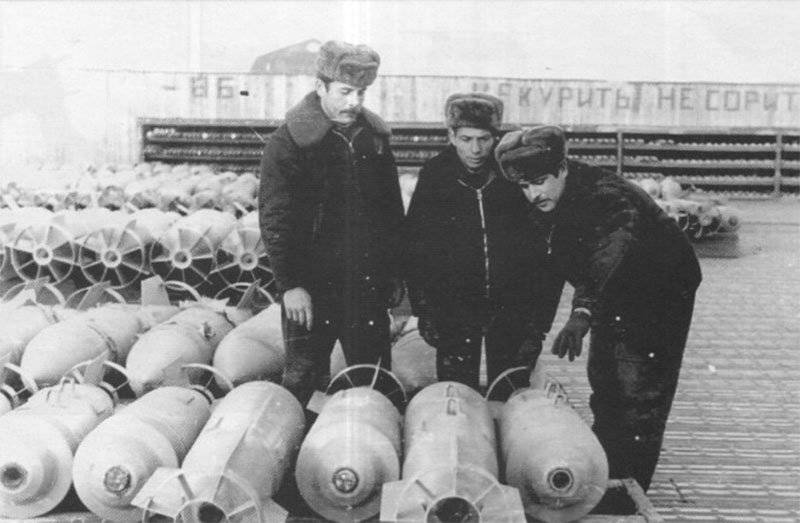
At first, it was necessary to restrict ourselves almost exclusively to the actions of couples, but with the buildup of the aviation grouping, the couples changed more solid shock groups. The strikes were launched in groups in 4 - 8 fighters, since in conditions where everyone was blowing in the villages, a rock and a crevice in the mountains could serve as a shelter for the enemy, an attack with smaller forces was ineffective. If necessary, 12 - 16 aircraft departed to bombard bases and fortified areas. A feature of the actions of fighter aviation was the work on objects located in high-altitude areas, where helicopters and attack aircraft could not reach. The fighters also participated in the posting of transport convoys, while attempting to fire, forming the "outer ring" of guards by strikes at the identified firing positions. Directly behind the convoy were helicopters accompanying it.
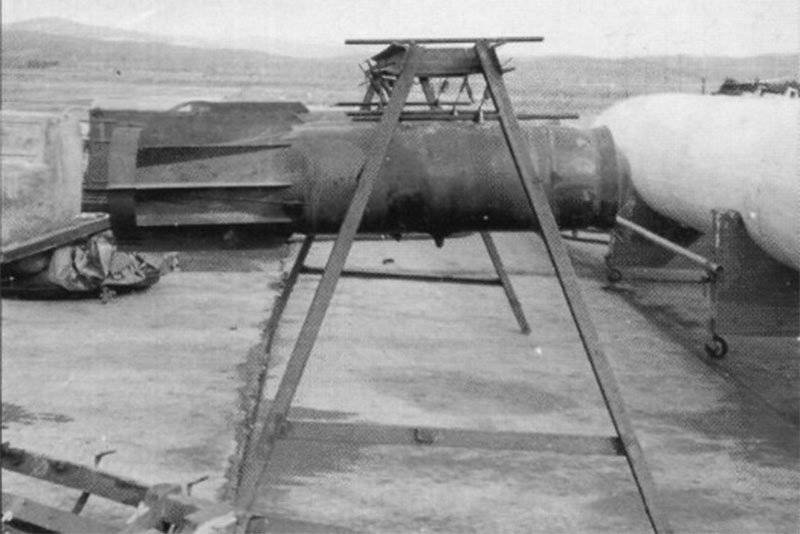
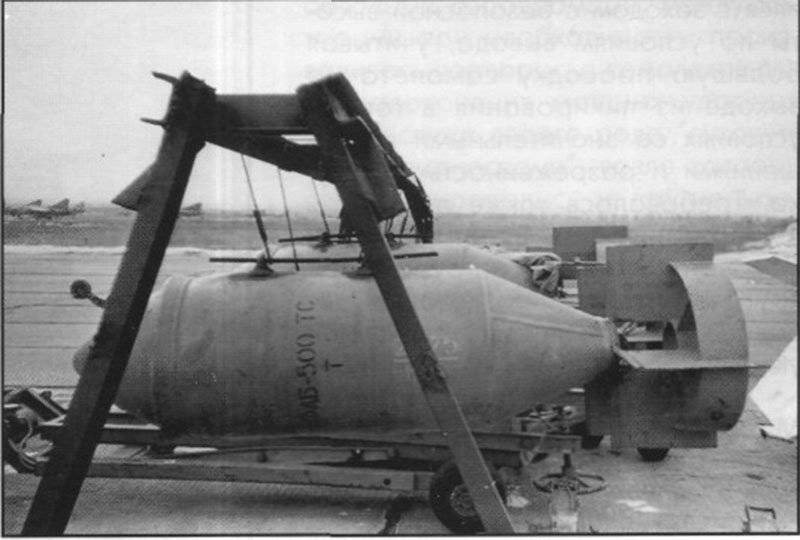
For more reliable interaction with aviation, they began to include spotters and aircraft manufacturers in the columns. They were appointed from among the pilots and navigators who for various reasons left their flight work, guided by the considerations that they are quite well aware of the specifics of activity in the air and, at least, they know what the terrain and the target look like from above. In the usual way, up to two battalions of motorized rifle troops or paratroopers with the necessary reinforcement of armored vehicles and artillery, as well as engineering units for demining and removing debris during road clearance, were involved in the behavior of the raid operation. As part of the operations management team, there was a representative from the airmen, who was assigned a specially equipped BTR, equipped with radio stations for communication with the Air Force command post. Such a group of combat aviation control (GBU) during military operations was attached to each motorized rifle or airborne battalion. Aircraft pilots who were next to the commander of a motorized rifle or airborne unit were sent to companies, moving on armored personnel carriers and infantry fighting vehicles. The duty of the gunner required constant attention, good orientation on the terrain, and tactical abilities. The effectiveness of aviation support depended on it. The spotters, who accompanied the troops in battle formations, should also have considerable stamina: they had to drag themselves over a bulky walkie-talkie with an 23-kilogram battery pack. For this, two people were usually appointed, including an assistant soldier to carry a pack with batteries. Sometimes a hand-held portable generator, known as a “motor soldier”, was used. In the mountains that screened the passage of radio waves, to ensure radio communications, it became necessary to attract special An-26PT repeater planes that constantly "hung" above the scene of hostilities. During the first year of the war, 620 sorties were flown with a total 2150 hours of flight control to ensure control of their troops.
The position of their troops during the attack was indicated by the colored smoke of the signal blocks, and the pilots were determined from them when searching for targets, guided by commands from the ground. The use of weapons by pilots was allowed only with the permission of the aircraft manufacturer, who received the go-ahead from the commander of the land unit, to whom he was assigned. Thereby, the probability of striking a blow was reduced to a minimum, which could not be avoided by independent actions of aviation. Paraphrasing the well-known remark that “war is too serious a matter to be entrusted to the military,” it can be said that military aviation is too formidable a force to entrust the pilots to control it.
Opponent quickly appreciated the value of "managers" and tried to disable them in the first place. Captured Mujahideen told that they were specifically instructed to detect and destroy aircraft builders. Among the airmen, officers of the combat command bore the greatest losses, earning the lines in the song:
Another tactical innovation was the interaction of aviation with artillery: the pilots struck at the gaps, aiming at the clearly visible clouds of dust at the target.
The organization of search and rescue operations has become another indispensable condition for ensuring aviation operations. Downed crew had to have a firm belief that he would not be left in danger. At each aerodrome, in the course of flight operations, there was a pair of Mi-8 search and rescue services (MSS) waiting for a call. However, this duty had the disadvantage that it took some time to get to the site of a forced landing or landing of the pilot, which could have ended sadly for those who were on the territory controlled by the enemy. Dushmans did not miss the chance to get even with the hated aviators, and even meeting with the ordinary inhabitants of the village, on which they had just been bombed, did not promise anything good.
Efficiency of the MSS was the primary condition for its activity, and there were many tragic cases when literally a dozen minutes of delay ended tragically for the downed pilot. The most effective measure was the provision of assistance to victims from the position of duty in the air with helicopter escort of the strike group. The presence of MSS helicopters over the impact site allowed the knocked-down crew to be immediately pulled from the ground. For 1980, 57 search and rescue operations were carried out (there were significantly more departures, because sometimes we had to lift several helicopter pairs in a row to select one crew), 126 was rescued by flight personnel.
"Bis" confidently lifted up to a ton of bombs, but took the full load only when working in nearby areas. Usually, the MiG-21 carried a charge that did not exceed two 250-kg bombs - the rarefied air of high mountains and heat affected (already at the usual + 35 ° places, the thrust of the Р25-300 engines fell by 15%). Under these conditions, with a normal take-off weight, the run-up of the aircraft reached 1500 m versus the usual 850 m. With "five hundred" aircraft, moreover, it became difficult to control on takeoff and noticeably lost rate of climb. It was risky to take a large bomb load by reducing refueling - the pilots preferred to have a navigation fuel reserve when they returned home. If, nevertheless, it was not possible to find the airfield, the instruction ordered to head for the north and, after the full development of the fuel, to eject over Soviet territory.
The most frequently used high-explosive bombs FAB-250 and high-explosive high-explosive OFAB-250-270 with a lesion area of one and a half hectares, as well as one-time bomb cassettes of RBC-250 and RBC-250-275, differing in filling. The discarded cassette was triggered at a set height and its contents were thrown out with a pulling charge from the usual hunting black powder, providing a covering for the vast area. The striking characteristics of fragmentation bombs of such caliber made it possible to fight not only with manpower, but also quite satisfactorily could be used in the case of defeat of cars in Dushman caravans and rifle positions, usually covered with stones, carried by small bombs.
Five hundred kilogram cassettes of RBC-500 had even greater efficiency. RBC-500 carried 550 - 560 spherical polukilogrammovyh bombs SHOAB-0,5. The small caliber of ammunition was more than compensated for by the vastness of the affected area and the penetration of the filling of the cassette everywhere, cutting in manpower and firing positions with a shower of slaughter elements.
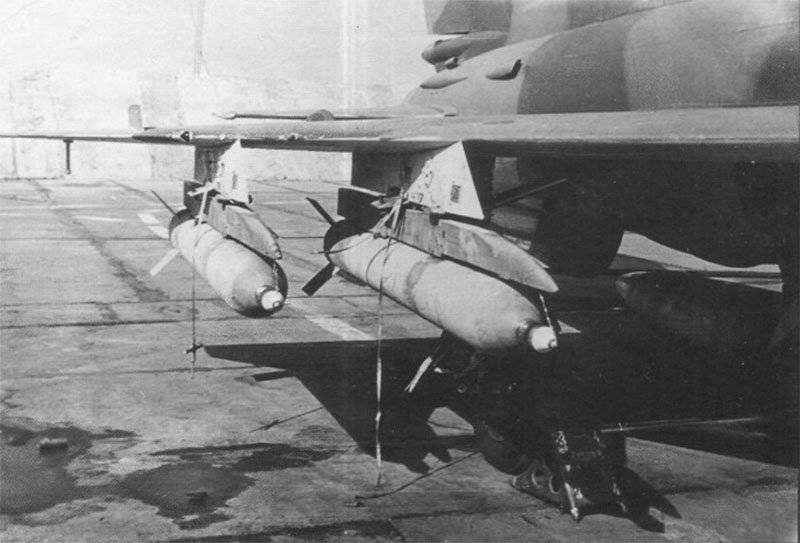
Uncontrollable rockets (NAR) of the C-5 type of different versions, launched from the universal blocks UB-16-57 and UB-32, were massively used. 57 mm caliber rockets combined high-explosive and fragmentation effects, for which in their modern versions they were equipped with a fragmentation shirt in the form of steel rings mounted on the body with cuts that spread over hundreds of slaughter segments. Against manpower - large and small gangs in the bases of the Mujahideen, pack animals in caravans - special C-5С missiles with arrow-shaped striking elements were also used. Each such rocket carried 1000 feathered arrows the size of a nail, on approaching a target ejected forward with a expelling charge and capable of riddling everything in the 10 - 15 m2 area.
The “Godfather” of the new weapon was the Commander-in-Chief of the Air Force, PS. Kutakhov, who was following the new weapons and did not miss the opportunity to ask about the effectiveness of the "shooter" in real combat use. As it turned out, the use of C-5С on airplanes turned out to be even much more productive than on combat helicopters, in which NAR units were practically everyday weapons. As it turned out, this advantage was facilitated by the speed of the aircraft, which was several times greater than the speed of helicopter flight modes. As a result, light arrows, weighing a little more than a gram, quickly lost their energy and penetrating power, being unable to hit a target and even pierce clothes. An obstacle for them was even the bushes, which served as a shelter for dushmans. At the same time, when launched from an airplane, the speed of the shot arrow was combined with the airplane’s own speed, the kinetic energy was several times higher, as was the superior striking effect, which was enough even to break through the branches and planks of the buildings.
When firing the NAR, the appearance of a volley of dozens of missiles had a significant impact on the enemy, after which the target disappeared in continuous gaps. Another common type of weapon was the large-caliber 240-mm NAR C-24, the large launch range of which allowed the pilots to feel more confident in the mountain gaps, which were constrained to maneuver, during the exit from the attack. The powerful high-explosive fragmentation warhead of the C-24 carried thick-walled adobe duval to the dust, behind which dushmans were hiding, and turned firing points in the mountains into piles of stones. In terms of its effectiveness, the C-24 combat unit was not inferior to a heavy projectile and gave large fragments to the 4000, which hit the enemy on the 300-400 m.
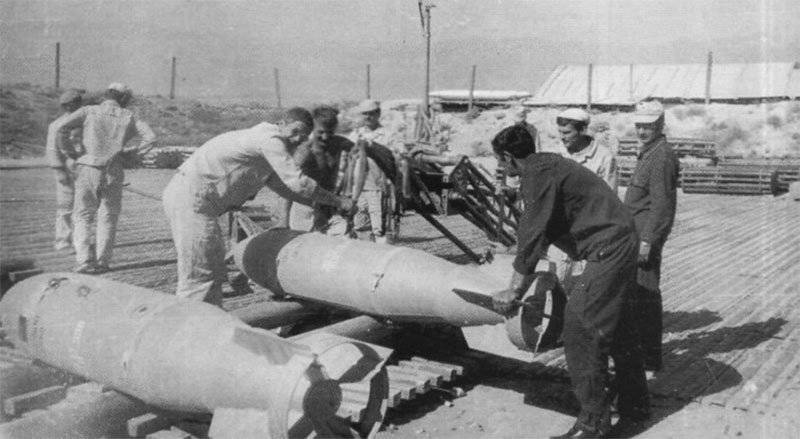
When destroying "hard nuts" like rock shelters and caves that served dushmans with safe havens and warehouses, thick-walled FAB-250TS bombs and, especially, FAB-500TS, which had a solid cast body, gave the best results (you could hit the cave with ordinary fagaskas if you hit barely noticeable mouth, and explosions on the surface gave only potholes). Such an ammunition with a solid body of high-quality steel and a cast head of twenty-centimeter thickness had the best penetrating effect, in which the power of the explosion was not wasted on the surface, but cracked in depth, causing collapses and caving in arches. A thick-walled bomb, punching a rock and bursting in the thick of a stone, caused collapses and collapse of caverns arches. Such ammunition was widely used in the "closure" of the base in the mountain range of Lurkoh in the province of Farah in January 1981, in the Black Mountains in September of the same year, where spooks tried to cut the road to Kandahar and in other places. Most often, however, the choice of ammunition was determined by their presence in warehouses due to difficulties with the supply. Sometimes, the reserves were exhausted to such an extent that the command reduced the rate to a minimum, forcing pilots to take no more than one bomb at a time (this situation, in particular, developed on the airfields by the end of the summer 1983 of the year). Always MiG-21bis carried full ammunition to the gun. At first, the pilots used cannon fire quite often, returning from a mission with empty cartridge boxes. Over time, when the air defense counteraction became more tangible, the gun lost its meaning - its use required small heights and short ranges. When firing from the flat dive, most advantageous under the conditions of aiming shooting, it was necessary to open fire from a distance of less than 1500 m, leading the aircraft to the height of 300-400 m, in the very density of anti-aircraft fire. Such tactics have been replaced by the most dynamic piloting possible and the pace when striking from a height at a speed and with an energetic withdrawal from the attack and antiaircraft fire zone. With such actions, the bombs and, if necessary, the NAR were much more profitable. Another reason for minimizing the use of the onboard gun was the bustle of its equipment: to prepare the gun, it was necessary to carry out its cleaning with complete disassembly after the previous shooting, removing it from the aircraft. With the help of a special machine, it was necessary to fill the 200 tape with cartridges and place it in the sleeves of a gun installation in the fuselage, after preparing the cartridges, each of which, after opening the zinc, should be thoroughly wiped and then checked for stacking in the links of the tape without protrusions and distortions. All this took a lot of time and effort, which is why the most uncomplicated weapons were in the first place: you could hang bombs and stuff NAR units much sooner and without special adaptations, and even non-specialists, technicians and soldiers could do it.
Thanks to the good skills, the squadron was able to fully prepare the bomb suspension in just 25-30 minutes. However, after the loss of significance by the cannon during the fulfillment of the main mission, the fighters were necessarily filled with cartridges: the gun remained a kind of pilot’s “personal weapon”, which could be useful after using the suspensions.
In total, for the first year of the war, 40 Army air forces carried out 72000 order sorties with a total 83000 flight time, including at low and extremely low altitudes — 59700 hours, at medium and high altitudes — 12100 hours and in the stratosphere - a little more than 30 hours (the latter were carried out by fighters in the course of combat training, which required the pilots to retain their skills, since without the corresponding exercises the next grade level was not assigned). 7810 bombings were made. The ammunition consumption amounted to over 12600 high-explosive and high-explosive fragmentation bombs, about 1850 disposable bomb cassettes of different types, about 240 concrete bombs, 450 incendiary tanks and bombs, 40 space-detonating bombs and 1050 lighting bombs. The high-explosive high-explosive bombs OFAB-250-270 (36% of the total number of bombers) and OFAB-100-120 (14% of all consumed) were used predominantly. All types of missiles (C-5, C-8, C-24 and C-25) have developed almost 635000 pieces. If it is not possible to indicate what proportion of the total number of fighters was used on the aforementioned weapons, then specific figures can be reported for cannon armaments. The ammunition for the GSH-23L guns on the MiG-21bis was spent for the year around 290500 (almost 1500 full ammunition or 60 ammunition per aircraft). Such expenditure of cannon ammunition by 40 Army Air Force fighters more than 20 times the consumption of ammunition by Su-17 fighter-bomber fighters.
Afghan pilots flew MiG-21МФ and MiG-21bis, which were part of the 322 th Fighter Regiment. By the spring of 1980, the 50 MiG-17F / PF fighter jets were also used in Mazar-i-Sharif, which were used for ground attack and training purposes. In the piloting technique, many of the Afghans were not inferior to the Soviet pilots, and the reason for this was by no means deep in "ideological conviction" and revolutionary moods. Afghan pilots for the most part came from noble Pashtun and Tajik clans, felt relaxed in the air and paid little attention to all sorts of instructions and restrictions, as in our Air Force. At the same time, however, their fighting efficiency could not be called high - Afghans flew at most one or two days a week, with mandatory quran-prescribed weekends on Fridays. They didn’t bother themselves with the fulfillment of combat missions, considering the bomb load from a couple of "weave" to be quite sufficient (and even those often lay away from the target). It happened that local gunsmiths forgot to take out checks from the bomb fuses, turning them into useless cargo. The headquarters of the 40 Army noted: "In the independent actions, the Afghans lose the desire to fight" and, in order to increase the effectiveness of combat work, the Soviet instructors often had to occupy seats in the cockpits of Afghan planes. In one of these 12 sorties in November 1985, the adviser to the Afghan Air Force, Major General N.A., was killed. Vlasov. While flying from Kandahar to Shindand on the MiG-21bis, his plane was shot down by the DShK. The pilot ejected, but when an enemy attempted to capture him, he died in a battle on the ground.
The preparation of the Allied machines left much to be desired, and with the slightest damage, the planes did not even try to restore them, starting up for spare parts, or simply plundering. Landmark of the Shindand airfield for a long time was the plane that “missed” when landing, the tail of which protruded from the breach in the wall of the local command post, from the second floor of which the teams continued to spread. Air Force DRA lost in 3-4 times more cars than the Soviet part, because the receipt of the gratuitous equipment from the USSR was guaranteed. However, no one had any illusions about the fate of the supplies, and among these planes there were those who managed to make war with the repaired cars, which still kept asterisks on the sides - marks about the sorties.
The main burden of combat work remained on Soviet aviators, who knew neither weekends nor holidays. During the year of their stay at the DRA, they managed to fly the 2,5-3 norms of “peacetime”, while on separate planes they carried out 450-470 sorties. For 1984, fighter aircraft accounted for 28% of the total number of BSHU and 6% of all reconnaissance flights. The intensity of the combat work of the fighter pilots was one third higher than in the fighter-bomber aviation and even ahead of the attack aircraft, second only to the crews of helicopters. Over time, the increased load forced the shelves to be completed with a second composition of pilots and technicians from other parts. This made it possible to acquire combat experience for a greater number of aviators and, if possible, to keep the load on people within acceptable limits (although at the same time every working day, starting even before the sun rose, lasted 12-14 hours, and the regiment managed to "rework" 15, 20 , and then 30 tons of bombs and "permissible limits" boiled down to the fact that people still did not fall down due to fatigue).
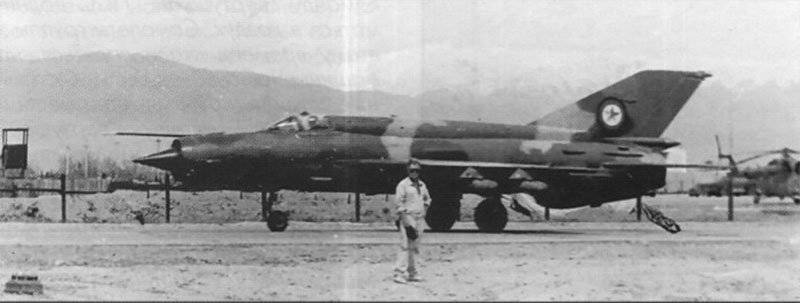
Although many missions had to be performed at the limit of the capabilities of the technology, the reliability of the MiG-21 was very high. Combat machines accounted for 85-90% and even with complex systems (navigation and radio equipment) the number of failures was small. Glare caused glare lantern, quickly yellowing and losing transparency from the sun and dust. The omnipresent, all-pervasive dust threatened to completely clog fuel filters and fuel fittings jets, forcing them to be cleaned as often as possible. The nozzles were blown through with compressed air, and a special installation was required to clean the filters, which “knocked out” the precipitated sediment by ultrasonic shaking.
Due to the rarefaction of air and heat, the landing speed was much faster than normal, which affected the chassis, the operation of shock absorbers and wheels. In the summer heat, planes met with watering machines or simply with buckets of water in order to quickly cool overheated wheels - otherwise pressure could smash pneumatics. The brake discs were worn out several times faster than usual, and the tires of the wheels literally “burned” at the airfields. Trouble was caused by the ever-blowing wind that brought stones to the strip, which polished with pneumatics.
Intensive operation still could not affect the state of technology - due to lack of time, maintenance work was carried out in haste, repairing and patching aircraft had to be in place. After a year of work, numerous defects accumulated on them, the resource was completely “knocked out”, and on returning to the USSR fighters had to be sent to overhaul. The evidence was also confirmed by the reporting data: accidents due to non-combat reasons under difficult working conditions were not inferior, and often exceeded losses from enemy fire.
At first, the enemy’s air defenses were insignificant. Dushmans had only small arms, had no tactical training, and shooting at an aerial target required training. The prisoners said that the “Chinese method” was practiced predominantly, when the entire detachment opened fire from machine guns, aiming for the flying plane in the hope that it would hit the curtain of flying bullets. In the 115-iap from time to time planes came with holes. One day, after hitting the DShK bulletin in the radio compartment, electric hoses were broken in front of the cockpit and the short circuit turned into a fire, which burned part of the compartment and equipment. Nevertheless, the plane was able to return and sit down, and after repair, return to service. 22 January 1980, a fighter in flight came under fire that damaged the engine. Bullet hits ruptured compressor blades, received multiple nicks and tears of material the size of a finger. Nevertheless, the engine continued to work and literally reached the car to the airfield. When departing 26 August 1980, the pilot MiG-21 bis felt a blow at the bottom of the aircraft. On the returning fighter, seven fragmentation holes were counted, some in the size of a fist; The responder’s antennas were torn down and the first four stages of the engine compressor were nicked.
August 1 1980 has not returned from the assignment of the MiG-21bis Senior Lieutenant Viktor Cheshenko. As part of the group, he carried out missions at Jabal-Ussaraj. The participants of the departure told about the incident: “This happened very close to the Bagram airfield, before entering the Panjshir ravine. The strike was struck with two links. The pair where Cheshenko was the lead and Ivan Chernenko the follower was the second in the link. C-24 and two OFAB-250-270 bombs. The second link went higher waiting for their turn to enter. When they came to work with C-24 shells, Ivan Chernenko let go of the lead, increasing the distance in order to better aim for more reliable hitting the target. . After withdrawal from attack, he is not updated. he led the leader. Several times the slave asked for him, but Cheshenko didn’t answer. In no case should a couple be dismissed during the work, the master and the follower are a single whole, they act together and cover each other, they are taught first and foremost. in the Afghan war, it was open, and such truths can not be neglected.
The commander of the second link, Major Andrei Tikhonov, who was above, later told me that he saw a strong explosion on the ground with a bright flash and thought that they were in a warehouse with ammunition. Here, the flight director, Lieutenant Colonel Khokhlov, announced that Cheshenko was not observed on the screens and gave the command to the PSS "turntables" to take to the air. The aircraft of the group by this time began to land, but Cheshenko's car was not there. The rest went in circles over the place of impact, waited for news from the "turntables", hoping for a miracle.
Helicopters went to the site to find out the situation and pick up the remnants of the aircraft and try to find the pilot. There they were met with strongest fire, fired from the slopes of the mountains with everything that could shoot. The helicopter pilots had to first process enemy positions by the NURS, and only after that they landed paratroopers. Those managed to take one "spirit" and collect the remnants of the aircraft (which could pick up). At the base, we have already examined the wreckage and found bullet holes in the patch tank at the level of the pilot’s cabin along the entire length from the cabin to the keel. Apparently, she slashed the automatic or machine-gun fire, and the pilot was killed in the cockpit at the time of withdrawal from attack. This was confirmed by the prisoner, who said that they had shot everything at once to create a wall of fire when the plane was descending.
There was no farewell to the dead, they sent him to the transport home and that's all. We asked the political officer why they did this not in a human way, he answered - they say, the decision was made not to demoralize the pilots so that there was no fear of flying. Of course, all were suppressed by the death of a military friend and comrade, but everyone believed that the pilot who died on the sortie should be escorted honorably, with all the honors and salute. He then only turned 25 years old, already in Afghanistan. "
Three months later, on November 12 of the year 1980, while attacking in the area of Faizabad, the plane of Captain Alexei Prokazin’s chief of staff of the squadron was shot down. The raid was performed by squadron squadrons with combat exercises of two OFAB-250-270 bombs and a pair of underwing outboard fuel tanks with a capacity of 490 l. Target designation provided helicopters, launches NAR outlined goals. They also warned that the BRC is operating in the target area. Major V. Fedchenko, a leading Komésque, made the decision to first attack single-handedly so that the helicopter pilots would correct the strike for the rest of them by breaking the bombs. Walked by his slave Prokazin followed in a dive, from which his MiG-21bis did not leave. On a steep descent, his plane lost control and the presenter heard only "In the corkscrew! Catap ..." The pilot managed to leave the plane - from the neighboring cars they clearly saw the chair and the lantern flying off from the MiG. Almost immediately over the mountains parachute opened. The remaining pilots of the group began to decline to cover up Prokazin.
The helicopter pilots who went to rescue the pilot had a hard time - the height of the slope on which he landed was at 3500 m, and rarefied air did not hold the Mi-8, whose bearing properties were not enough to hold and land the car. Something from the next minute’s entry through 15, I was able to sit down and pick up Prokazin. He himself said at home: “After the ejection, he almost immediately landed. The slope was steep, I rolled down and caught on the stones, entangled in the slings and hung upside down. I heard shooting - they were scorching nearby, getting rid of the straps of the tether system. Then he climbed up the slope, realizing that otherwise I wouldn’t be noticed below. I remembered the machine gun, but I didn’t have it on my belt. I saw helicopters working around the "spirits" circling below, and another trying to get on top. Covers Wander even more vigorously, getting to the place where the “spinner” was trying to sit down. My heart was pounding wildly, there was not enough air, I thought my heart would jump out of my chest at all. Torn my nails while climbing up the stones. When the helicopter did get out, only undertook - ran to him, waving his bag. Very lucky, there was practically no chance, but still managed to get out. And then he met the helicopter pilot - they presented him to the Hero, but he never got anything, even though he had the most regiment combat missions. "
The cause of the loss of the aircraft Prokazina could be his defeat by enemy anti-aircraft fire, or, judging by the behavior of the machine and the first report of the pilot himself, the loss of controllability during a dive is more likely. The task was by no means simple and required good training for the pilot and the technology of execution: at height, entering into a dive should be carried out vigorously, with switching on afterburner and overloading to reduce the loss of height at the hatch. The aircraft on a dive accelerated to the speed of sound, critical when suspended tanks and half-bombs were under the wing, pulling together for one and a half tons. The load on the wing was increased and suffered aerodynamics, which in the transonic range at the output could lead to a “catch” and overload with overload with loss of control. Major-General Shpak, Deputy Air Force Commander of the 40 Army, conducted an investigation of the incident, but all the participants in the departure claimed that the plane was shot down.
With the rise of air defense of the Mujahideen, the planes more and more often came across anti-aircraft fire. According to the pilots, the mountains are literally sparked by “welding”, especially near bases and strong points covered with 12,7-mm DShK machineguns, usually beaten off by government units or Chinese-made, and PGI’s 14,5-mm anti-aircraft guns with a range of 2000 meters. 1985 year, they accounted for 62,5% of all combat damage aircraft. The main reasons for the loss of the Air Force Command recognized the shortcomings in the planning of operations and the inadequate accounting of enemy air defenses.
In order to catch the Mujahideen by surprise and not let the fire be organized, attacks from ultra-low heights (up to 50 - 60 m) were first practiced. However, this tactic developed for the European theater did not meet with enthusiasm among the pilots, as in difficult terrain on such low-altitude flights it was necessary to reduce speed, and when lowered into intermountain, there was a great risk of running into an ambush or getting under fire from above. It has become more practical to lay safe "bypass" routes, reach the target from directions not covered by air defense, and take you to safe heights.
In addition, they began to apply "active measures" - to allocate special groups to suppress air defense. The fight against anti-aircraft weapons turned out to be unsafe - the position could only be destroyed by a direct hit, otherwise the next one would immediately replace the “knocked out” calculation, and the fire resumed (sometimes 2 - 3 was replaced one by one). Often, the enemy equipped a number of anti-aircraft points, separated by height, and the plane that attacked one of them came under fire from the neighboring ones. In addition, their exact position was not always revealed in advance and intelligence information was often limited only to information about the expected presence of zenith points in the area. To reduce the time spent under fire, the blow should have been delivered at high speed, not lower than 950-1000 km / h, and for this, fighters armed with NAR or RBC were most often assigned. In the MiG-21, swift and smaller in size than the Su-17, it was not easy to get. For speed and maneuverability, "smart temper", the MiG-21 in Afghanistan was nicknamed "fun" and the team to call fighters from KP sounded like this: "Link" merry "to raise in such and such an area." At the same time, the tactics of the fighters had their own characteristics: to achieve surprise, the blow was struck from the sun, blinding the shooters, the fighters exited the attack, with a vigorous climb and a sharp “hook” to the side; if necessary, a "star raid" ("daisy") was performed, in which attacks followed continuously from different directions, making it difficult for the Mujahideen to conduct aimed fire. Sometimes they isolated a demonstration link that imitated a raid and distracted the attention of anti-aircraft gunners, while the strike group went on the attack from the other side.
To protect against the enemy's modern anti-aircraft weapons - MANPADS with missiles that reacted to the heat of aircraft engines - MiG-21 bis were modified with the installation of ASO-2В cassettes with heat traps. These cassettes were hung on the attachment points of the starting accelerators in the lower part of the fuselage. The cassettes were equipped with several dozens of squibs, which, during the shooting, flared up, with high temperatures distracting the homing missiles.
Clearing the ground from the centers of anti-aircraft fire was accompanied not only by air raids, but also by the landing of helicopter assault forces. A typical construction of a strike on a fortified significant object could include the inclusion of several groups with a specific purpose. They processed the target in a consistent manner. The first object to be attacked was the air defense suppression group from a pair or a MiG-21 link that struck the object and the mountain slopes on both sides of the intended combat course of the main group using RBC with fragmentation equipment and units with C-5 projectiles. Following the very approach of the strike group, a pair of Mi-8 helicopters designated a target with bombs or a NAR that raised clearly visible clouds of dust. Gunners from local residents who collaborated with the army were often taken aboard (understandably, such services were paid accordingly). In the role of target designators could act a couple of aircraft from the shock group. The very strike on the target was inflicted by forces of one or two units of the MiG-21 with combat loading according to the task and the nature of the target. At the end of the raid, objective monitoring was carried out in an indispensable manner to identify the results, the nature of the defeat of the target, and the decision about the need for a second strike. For example, in a large operation conducted in January 1982 near the town of Darzab, the purpose of which was to destroy gangs in areas bordering the USSR, 12 fighter jets MiG-21bis, which carried RBC-250-275 with fragmentation "stuffing", were used to fight air defense .
The combat work of the 115 th iap as part of the 40 Army's air force continued until 12 June 1981, when the regiment was replaced by another part, also drawn from the southern districts. The 27 th Guards Vyborg Red Banner Fighter Wing Regiment, based in the town of Uch-Aral in southeastern Kazakhstan, bordering China, where the regiment was deployed at the beginning of 70's to strengthen the tense Chinese border, took over the baton. Apparently, when recruiting the forces of the Soviet contingent in Afghanistan, then the authorities still hoped to cope with the tasks of the local forces. In addition, the aviators who used to work in TurkVO and SAVO were more accustomed to the local conditions, the terrain itself and the characteristics of service in the local climate.
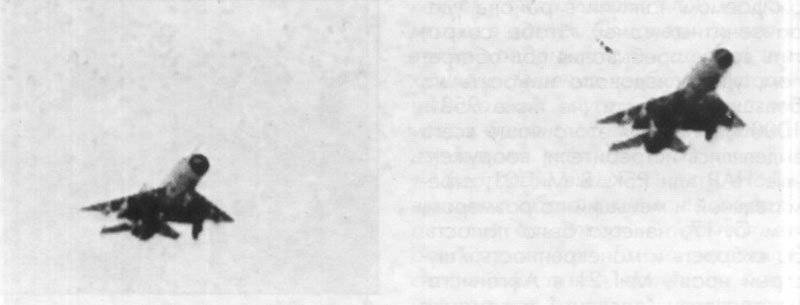
The fighter regiments sent to Afghanistan left part of the aircraft in place (so as not to expose the main-based airfield) and usually included two reinforced squadrons with a total number of 30-35 aircraft. The MiG-21US / UM combat trainer carried a particularly heavy load. In addition to training, the Sparky were used in outbound flights in which the pilots familiarized themselves with the combat area for reconnaissance and target designation (the instructor’s place was occupied by an experienced pilot or navigator who knew the area well, and an extra pair of eyes contributed to finding the target). With the help of "Sparok" carried out leadership, when over the impact site "hung" someone from the headquarters of the Air Force, and the subsequent control of the results of the raids.
The 27 regiment was commanded by Colonel Viktor Sevastyanovich Kot, the future commander of front-line aviation, who was awarded the title Hero of the Soviet Union for combat work in Afghanistan. The commander of the 1 squadron sent to Kandahar was Lieutenant Colonel V. Veropotvelyan, the 2 Squadron stationed together with the headquarters and the leadership team of the regiment in Bagram, Lieutenant Colonel K. Rybnikov.
For acquaintance with the peculiarities of combat use, places of future combat work and local specifics, the pilots flew for several days in the group with the alternating squadron of the 115 regiment. Already in the first combat missions, the novices got an idea of the complexity of the situation, having encountered serious resistance from the air defense of the dushmans. In one of the joint sortie 9 June 1 981, one of the MiG-21bis Uch-Aral regiment fell under automatic fire, bringing a lot of holes. The front pillars were pierced with bullets, the thrust was broken at the main landing gear rack, the hydraulic pipelines were destroyed and several electrical wires and electric fittings were killed. The aircraft was commissioned for several days. The return with broken hydraulics ended and the departure of the chief of staff of the regiment colonel Col. Yu.S. Shunov 27 June, in which when applying the BSHU along the fortress under Gardez in the south of Bagram, the DShK bullet smashed the armature control cone of the air intake.
The crash of captain V.A. Semenov, who had forgotten to close and seal the lamp before taxiing out (because of the heat, the pilot opened it, airing the cabin waiting for the "good" to launch). The lantern began to open during a takeoff run, aspirated by the air as it picked up speed. The pilot tried to hold him, taking control of the other hand, but immediately realized the hopelessness of these attempts (the pilot of another fighter regiment was recently killed in similar circumstances in an airplane). After stopping the take-off, he released a brake parachute and tightly clamped the wheel brakes. The parachute at the speed immediately torn off, the pneumatics burst during sudden braking, and the plane took out from the runway. Flying the ground, the fighter lost the outboard tank and the UB-16-57 unit, packed with missiles. Got and went to the slave lieutenant V. Reberko, whose plane ran up the lane, littered with fragments of wheels and tires scattered pneumatics.
When 29 departed on April 1982, the inhaler bullet of DShK hit the right wing tank, causing an explosion of kerosene fumes. Buck withstood the blow, but the lining bulged up, and the wing needed to be replaced entirely. They did not dare to overtake the damaged car to a repair company, and they had to restore the aircraft in the field. New console required to order at the factory, and then customized by plane, which took a month.
The list of combat damage to the 27 aircraft of the regiment even included damage from anti-personnel mines, which in the same week, 26 on April 1982 of the year, was shot at by the Bagram airfield. Mine fragments broke through the cone of one of the fighters and smashed the windshield of the lantern. Deep holes in the finger in several places mutilated the bulletproof glass, which had to be changed.
Already in the second week of combat work, the regiment suffered a loss: in a 15 June 1981 sortie, near the Tora Bora gorge in Nangarhar province, DShK was hit by a Spark with the crew of Major Viktor Moskovchuk and Captain Mikhail Korchinsky. The plane took off to monitor the results of the impact of other fighters, performing raids on a stronghold in the village. When passing over the target, the pilots sank for better visibility and the Spark was fired upon one who was standing on the roof of one of the DShK's houses. The rescue team was unable to approach the crash site due to the dense fire from the ground. Later still managed to pick up the wreckage of the aircraft, which found that Moskovchuk flying in the second cockpit was killed in the air, as indicated by bullet holes in the rear lamp and blood stains. Korchinsky managed to eject, after which he hid for three days from the "spirits" in the mountains, but nevertheless was captured and sent to Pakistan. The appeal of the local military was surprisingly respectful, and later the pilot was returned to the Soviet representatives. Upon his return, he was recovering at the hospital for a month, however, he did not fly fighter jets anymore, continuing to serve in transport aviation on the An-26.
The body of Moskovchuk was never found, which is why he was considered missing. His fellow soldiers have repeatedly raised the issue of recognizing him dead in the performance of a combat mission, but even after years at the highest levels they did not find the arguments convincing for the posthumous honoring of the pilot.
That same summer, 1981 of the year was shot down by the plane of the comask V. Veropotvelyan, who was leading the group of two links. After stopping the ignited engine to take off, the pilot had to eject, at the landing site he was covered with fire from other squadron airplanes and the Mi-8 arrived in time picked up the pilot.
Already before the withdrawal of the regiment home, he suffered another loss. 27 May 1982 of the year during a strike on the target at the village of Avund was shot down by MiG-21bis captain Andrei Sribnoy. Already at the exit from the attack, the leading pair, Major A. Zhelezov, glanced at the periscope of his plane and saw an explosion flash behind him. Sribnoy fighter exploded in the air - in all likelihood, anti-aircraft fire touched a suspended bomb.
In the middle of June, the 1982 th Fighter Regiment replaced the 27 Infantry 145. This time, "changing the tradition", fighters from the European part of the USSR were attracted to work in Afghanistan, from the air force of the Carpathian military district, where the regiment was based in Ivano-Frankivsk. The reasons had a simple explanation - the end of the war was not foreseen, and in the southern districts of the fighter units there was nothing at all and, guided by the previous selection methodology, we would have to send them to Afghanistan for the second time.
The queues were identified a year ago: in accordance with the directive of the General Staff of 17 on April 1981, the two-squadron squadron of 145-iap had to leave 1 on June 1982, “at the disposal of the commander of the Air Force TurkVO”. For the time being, the planned replacement, taking into account the examples of insufficient training of aviators and the complexity of the initial period of combat activity, was intended to organize preparations for combat work in the coming more than enough time. On the appointed day, a group of 24 combat MiG-21bis and four “Sparks” MiG-21UM set off on a flight of more than five thousand kilometers. The commander of the regimental group was Colonel Mikhail Konfindratov, the 1 squadron was commanded by Nikolay Blinov, the 2 was commanded by Lieutenant Colonel Vladimir Logachev. The flight took several days with five intermediate landings. The lessons of Afghanistan were duly taken into account: arriving in Kokaity, the group was delayed to acclimatize to a hot climate and to go through training before starting combat activities. True, the authorities somehow did not think that the planned fighter shifts were in the summer season, the most unfavorable for acclimatization, when the drying heat literally knocked people out of the usual rhythm. The pilots flew along the route several times to get an idea of the orientation over the mountain-desert terrain, worked at the test site for bombing and firing rockets.
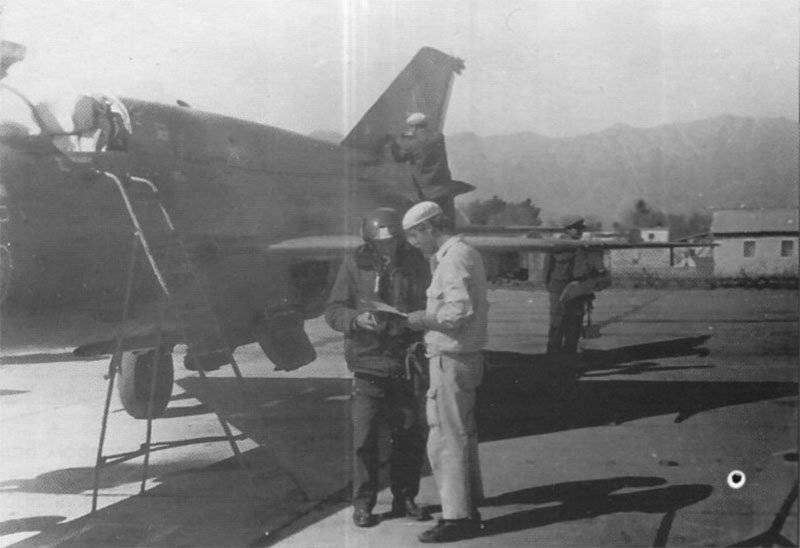
16-17 June 1982, the group flew to Afghanistan. The home base of the 1 Squadron became Bagram, the 2 Squadron was stationed in Kandahar. One link was constantly sent to Shindand for combat duty in the air defense system. To accomplish fighter missions while accompanying strike groups and patrolling border areas, the MiG-21bis were equipped with air combat missiles — usually four P-13M missiles or two P-13M missiles and two P-60 missiles. A combination of two P-13M weapons and a pair of bombs or RBC-250 could be used, so that, if necessary, it was possible to support the strike group by attacking identified firing points and air defense centers.
Proper training has reduced combat damage and losses to a minimum. The loss of flight personnel in the regiment was not. During their stay in Afghanistan, the 145 th iap lost only one MiG-21bis zampolit 1 squadron of Major Grigory Shapoval, shot down by Bagram 18 August 1982 of the year and successfully catapulted.
In the summer of 1982, the situation at the Kandahar airfield was extremely aggravated, where the enemy saddled adjacent roads and often fired at the campsites (as the aviators themselves joked: “spirits” put newbies into service ”). on the approaches to the base, turning off the highway into the sands and making their way to the airfield in a roundabout way. During mortar attacks and shelling with missiles, several mechanics and drivers were injured. During the shelling of 24 July, machine gun fire was seriously It was damaged by the MiG-21bis, which had a fuselage fuel tank stitched in with multiple holes, a flap of the fuselage was torn off, the power kit, frames and stringers were torn off with bullets. Three days later, another fighter received bullet holes in the shelling of the airfield. An automatic bullet struck a patch fuel tank in the gargrote at the filler neck. The hole was sealed with a piston set on a glue, and by the end of the day the plane was returned to service.
The 145 regiment stayed in Afghanistan for exactly 13 months. The regiment left the DRA 17 July 1983 of the year, having completed the return flight in just two days and on July 18 arrived home in Ivano-Frankivsk.
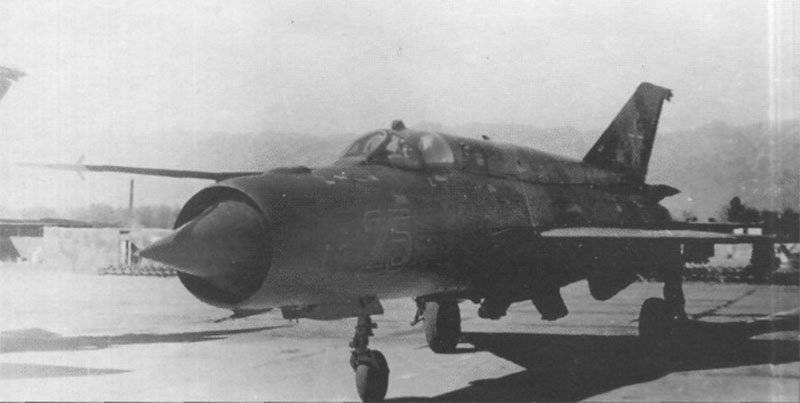
The order received the 927 th Königsberg Order of Alexander Nevsky Red Banner Fighter Regiment of the Air Force of the Belarusian Military District. The commander of the regiment was Colonel PP. Tarasevich. The 28 MiG-21bis fighters and four Sparky MiG-21UM were redeployed to Afghanistan. Upon arriving at the Kokayta 15 airfield on June 1983, the regiment was engaged in combat training for ten days. The flight to Afghan airports took place on June 25. The deployment was carried out according to the already established scheme at three airfields: Bagram served as the main base, the other fighters worked from the airfields of Kandahar and Shindand. For four days, the pilots performed joint flights with colleagues from the interchangeable 145-iap, taking on combat work zones.
The Belarusian regiment accounted for a large amount of combat activity. During this period, the army carried out several dozens of planned operations, including the famous "Big Panjsher" in the spring of 1984, unprecedented in scale and attracting aviation forces. According to the memories of the pilots, they flew almost every day and the only exception was 1 in January, 1984, for the reason that the Bagram airfield was covered with snow (but by the evening it had melted and had flown again). The schedule was also very tight: during scheduled work, it would rise at three in the morning, leave for breakfast at the airfield and receive pre-flight instructions after breakfast. The planes were preparing for departure, including the suspension of ammunition, already in the evening, and in 4.30 - 4.40 with the dawn followed the first departure. By five in the morning the planes were above the target, striking the first blow. Upon return, the planes were preparing for re-flight, refueling, equipping with arms, serving all systems and eliminating the noted remarks after the flight. The usual were three or four departures per shift. In the afternoon, with the onset of the midday heat, a break usually followed. Towards evening, the commander set the task the next day, describing the targets and possible anti-aircraft resistance, the time of the strike, the outfit of forces, and the combat loading of the planes were appointed.
Taking into account the unfavorable features of the situation, high temperatures, excess of airfields based on air rarefaction, affecting the load-bearing properties of the machines, take-off weight, fueling, reduction of the tactical radius of the planes and their time in the target area, combat loading was, if possible, assigned to be lowered against the stipulated "home" instructions. Accordingly, an increased outfit of forces was required for a reliable defeat of the target. Thus, for striking a typical object — a fortress — it was envisaged to isolate two units of the MiG-21 (six airplanes with a suspension of two high-explosive bombs FAB-500 and a pair with a suspension of two missiles C-24). A separate house in the village, which was a dimensional structure with thick-walled ducts, demanded an 8-10 strike; six of them carried four OFAB-250-270 bombs, and another four carried two C-24 bombs. Even the task of destroying a fortified firing point in the mountains made necessary the departure of a squadron, in which eight MiG-21s carried C-24 projectiles and a link - blocks with C-5 missiles. During operations on large caravans, two fighter units were assigned: the first attacked with high-explosive fragmentation bombs, four OFAB-250-270 on the plane, the next struck a rocket attack using the full version of the suspension of UB-32-16 units (two the use of different types of blocks of different capacity, two UB-57 on the inner wing nodes and two smaller UB-32-16 on the outer holders, was stipulated by the regulations for the operation of the MiG-57 bis due to the influence of such suspensions on the flight characteristics of the aircraft). It was considered necessary to send two units of the MiG-21 with a C-21 missile on six vehicles and two fragmentation equipment bombs on two fighters to attack the enemy’s detachment in open areas.
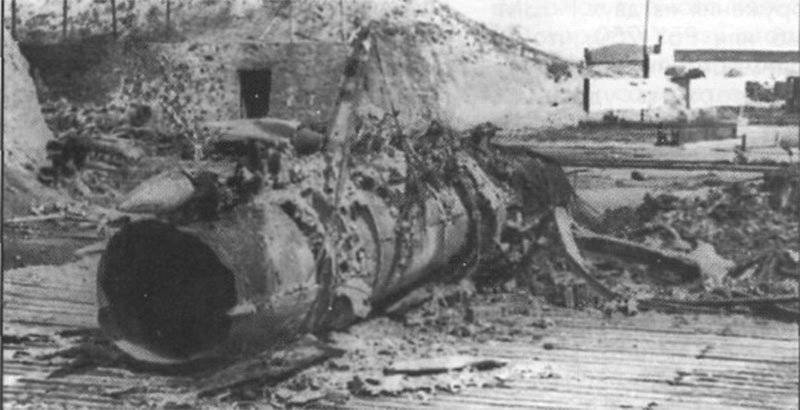
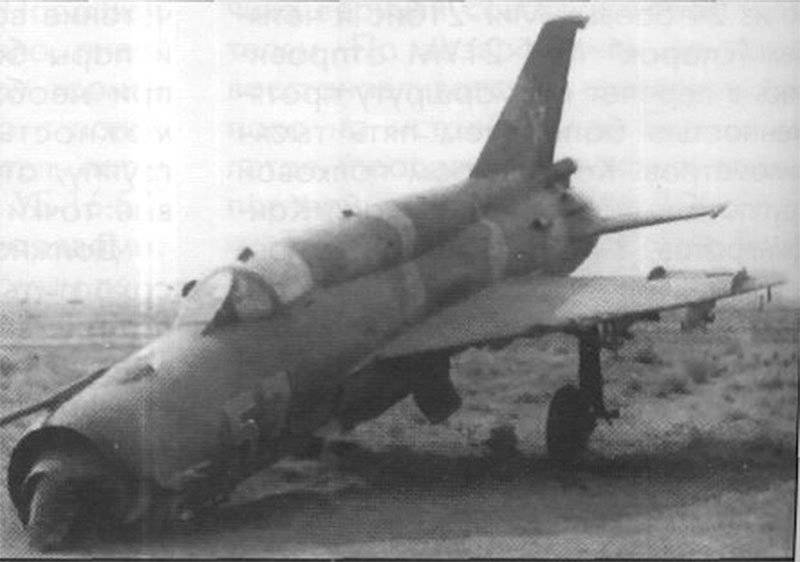
If the target was a living force located in the gorge, where the use of rockets was difficult due to the complexity of the approaches, the required outfit of forces increased almost twice with the corresponding armament, including six aircraft with OFAB-250-270 (four bombs each) and Four fighters with charging space-detonating bombs ODAB-500, particularly effective in the mountain gorge.
The 927 fighters flew up the 12 000 10000 watch with the execution of approximately 400 sorties. The average flight time on the plane was equal to 250 hours, the pilot accounted for from 400 to 16000 hours. During their stay in Afghanistan, the order was used 250 bombs of different types of caliber 500 and 1800 kg, 24 missiles C-250 and 000 23 cartridges for guns GSH-XNUMX.
The May days of 1984 were especially tense, when during the Panjshir operation some pilots flew up to 70 hours a month with 150 sorties, which amounted to a one-year flight at home. On one of the sorties in Panjshir on the eve of the operation, Captain Aleksey Gordiyuk spoke: “In the Chaugani region, a large convoy from the Union towards Salang only entered the mountains, about a couple of kilometers after the plain, and was attacked by“ spirits “there. Later, through the scouts learned about the operating gang of 160 barrels. The column was classically blocked by lined vehicles burning in the head and tail, cars were burning inside the chain. While we were from Bagram on call through the An-26RT repeater (which hung in the air all daylight every day), it arrived whether to the burning convoy to the rescue, the VHF connection with the gunner in this convoy was lost.To the shame of our commanders, even 40 years after the Great Patriotic War, she didn’t teach anyone anything: from tankers and armored personnel carriers one KV connection from us in aviation "to support" the ground forces of only VHF radio stations. Only the tank snapped with shots (from a height of 3000 m small arms can not be seen), but it was clear that they would not last long in the "bag" and the losses would be big. The situation "above" was considered hopeless: there was no gunner and communication, and the senior aboard the An-26 categorically forbade us to "work" and strictly ordered the group commander Major Glova to follow to the airfield. He began to be indignant: ours are dying, the entire column is in smoke, and “following” security measures in this situation is somehow out of place, we must at least give moral support to ours. They explained to him that this is an order. Then, after several minutes of "failure to comply with the military order," Glova declared for the prosecutor (the tape recorder recorded the broadcast on the "Anton"): I assume all responsibility. The voice "from above" fell silent: you know better. But to us from three thousand to enter a fighter nothing is visible except smoke and fire! And bombings on the slopes in the gorge can cover their own! And I want to help and prick without a gunner. On each of the four aircraft, four OFAB-250 pieces hung, enough for two calls each. Dropped part in the first call. The first pair, by a random reset, probably only mentally “shook” the attackers. Below, we were probably heard (not by the rumble of aircraft, but by bombings) only after the second call. And in the surviving tank smart guys sat and more often began to "target" shooting in one place, so that it "reached" us. And while it was the turn of the extreme in the group, it became clear where now it was necessary to “peck” for sure and effectively.
After being bombed, the four MiG-21bis destroyed 80 spirits from 160, marching to Punjer to support jihad. The survivors "changed their minds" and returned. Thus, Glova, as noted by then-General of Aviation, General Kolodiy, saved not only ours in the convoy, but also the combatants in the Panjshir operation. So there was no punishment for disobeying the authorities. Two weeks later, General Kolodiy, especially before the flight personnel of Bagram, cited as an example the decisive and the only correct actions in the difficult critical situation of Major Glova.
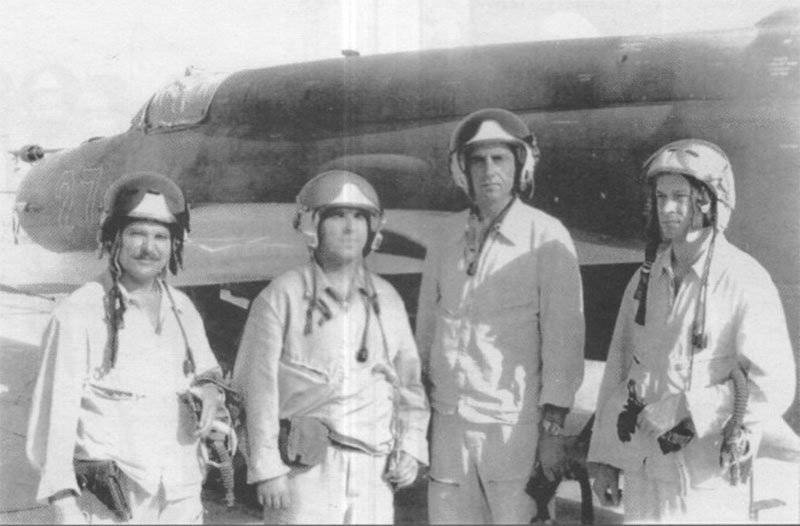
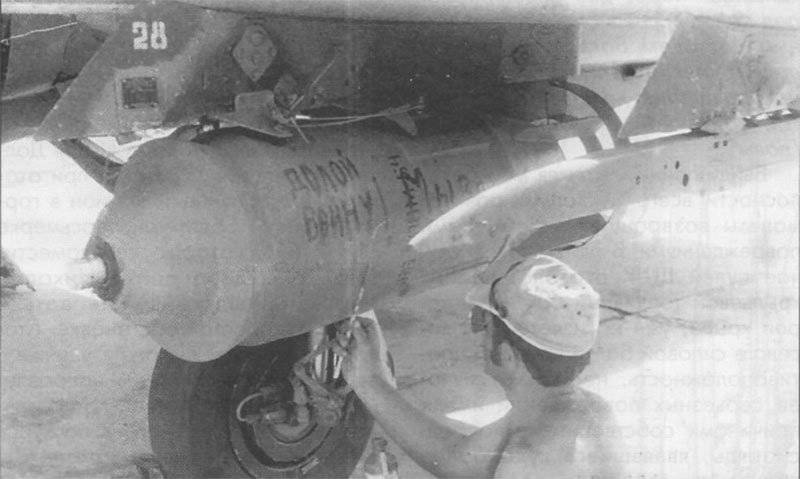
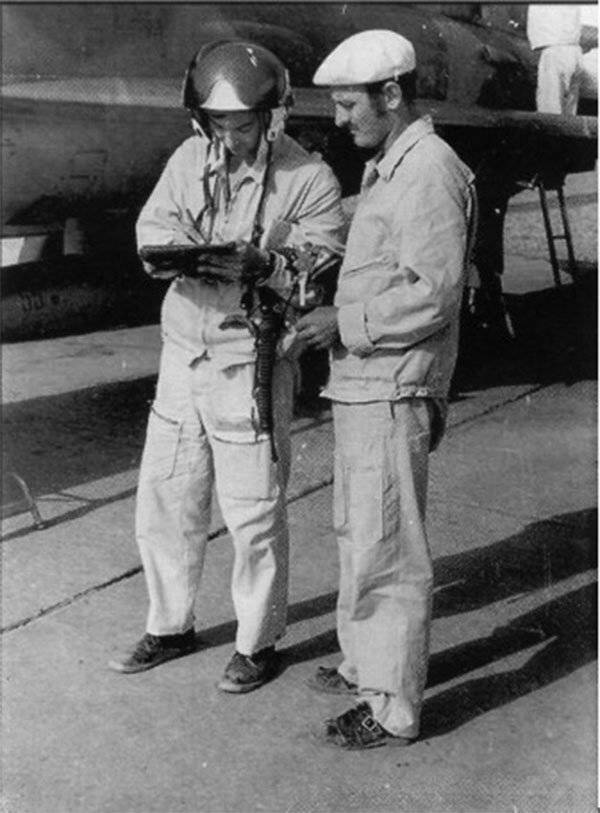
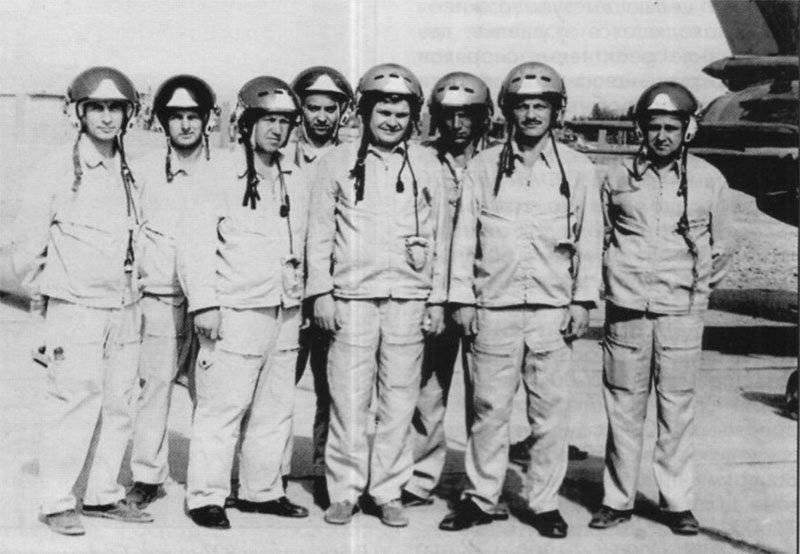
In view of the security measures taken, only a few times the aircraft returned with combat damage. In one such case, the DShK bullet was punched with a wing fuel tank and wing spar, already at izlelet the bullet sat down in the power beam of the wing. In contrast, several cases of serious damage were caused by their own fragments and projectiles, which were a far more serious means of destruction than dushman automata. In one of the incidents, the aircraft in a dive flew into fragments of a C-24 projectile, one of which, with a kilogram weight, struck the air intake cone and was stuck in the antenna of a radar sight.
In March, the 1984 of the year due to a defective technology was broken MiG-21bis. On the plane, due to a shortage of spare parts, they installed an air system valve from another machine. That turned out to be non-working and in the next flight the “etching” air left the system without pressure. When the aircraft landed, the main braking system did not work, and the release of the brake parachute refused. The fighter ran the entire runway, flew out to the ground and, breaking through the airfield barrier, broke the front strut. Nasal part was wrinkled and the air intake cone collapsed. The pilot did not teach a scratch, and the plane after the necessary repairs returned to service.
The first combat loss of the 927 regiment was the plane of the intelligence chief of the regiment, Major Igor Dolgikh. October 29 1983, while attacking a target in the province of Bamyan in the mountainous region of Badakhshan, the eight MiG-21bis, led by deputy regiment commander Nikolai Karev, had to operate in a very difficult situation. The attacked fortress lay in the gorge with the only possible direction of entry, which allowed the enemy to concentrate fire on the course of the expected approach of the aircraft. The bombing was carried out by assault bombs FAB-500ShN, because of the difficulties with bringing up others in the warehouse simply was not. Such ammunition was provided for low-altitude bombing from horizontal flight, but according to the situation it was necessary to drop them in the most inappropriate modes with a steep dive, which was accompanied by a considerable subsidence of the aircraft. Dolgikh's plane was closing in a link and got under the ZSU line. At the conclusion, the pilot heard a blow in the tail section of the vehicle, but the plane listened to the controls and was able to cross the mountain. After a few minutes, the pilot discovered a hydraulic failure and deterioration of control, but continued to pull to the airfield. On the way home, the flight crew accompanying him saw a kerosene trail of punched tanks, which suddenly turned into a fiery plume over 20 meters in length. An explosion was about to follow, and Dolgikh ejected already in view of Bagram at a distance of 30 km.
The pilot who had landed was covered by a group of cannon fire at the same time indicating the placers to the rescuers by the tracers. Helicopter pilots quickly discovered traces of dust from exploding shells, “snatching” the pilot within 10 minutes after landing. Dolgikh himself said: “After landing, he unfastened the tethering system, freed himself, looked around and took out a pistol. Nearby was a village. He turned around on a rustle, saw the crawling" spirit "and did not aim, fired first. He ran away - successfully, he was unarmed. Only he he wasn’t alone. Shots were heard from behind the wall of a nearby house. He made several shots in that direction. He didn’t hold out with a pistol for a long time, so he got into NAZ and took out an automatic rifle. Then he saw that a whole crowd of armed people was running to the landing site. But at the same moment arrived in The helicopters, one of the villages, walked in. The helicopter pilots immediately picked me up and went to take off. They took off under fire, then they saw several holes in the helicopter. When they were unloaded, they immediately put me on the door brought - the spine was suddenly damaged during the ejection. stress, well, and themselves "partaking" for the fact that everything turned out. Then the hospital, and after three months flew again.
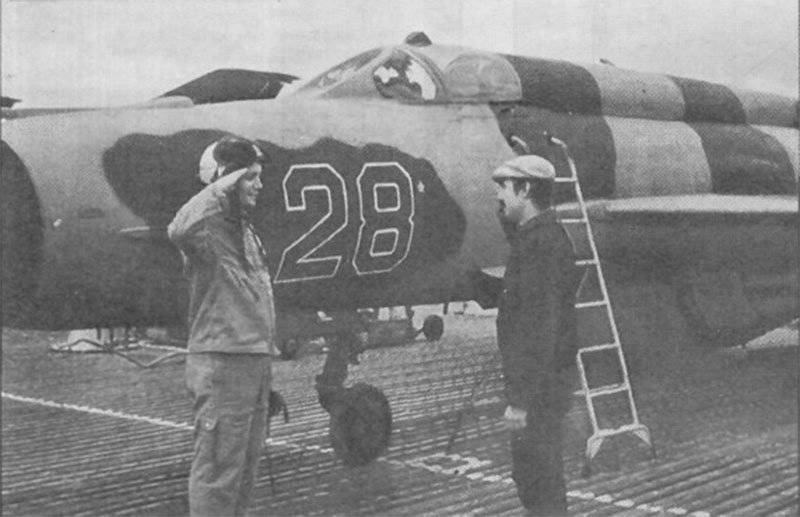
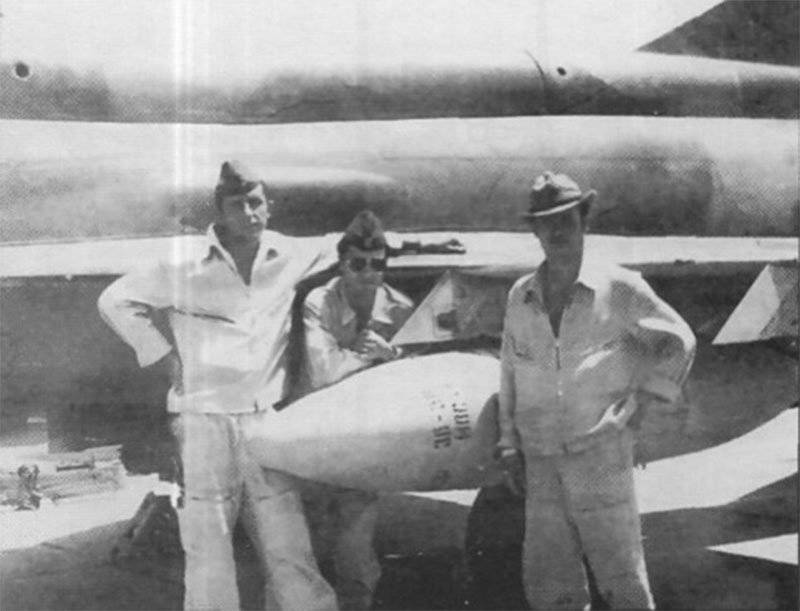
Shortly before returning home, 15 June 1984, the plane of Captain Alexey Gordiyuk was lost. The group struck at the village just six kilometers from the airfield. At the conclusion of the dive, the fighter lost control, began to rotate and the pilot ejected at an altitude of 1000 m with the aircraft turned upside down. After the ejection on the outskirts of the village, he was almost immediately picked up by a helicopter accompanying the search pair. For the pilot, it was the 193-th combat mission, because of what the management considered the likely reason for his loss of consciousness during the overload at the time of the withdrawal "because of the large physical and emotional exhaustion." The “Sparka” sent to the strike area was immediately fired from the ground, and she returned with a bullet hole in the hanging tank.
Danger trapped the aircraft and on the ground. In spite of helicopter patrols and the huge number of mines with which approaches to aerodromes were stuffed, from time to time it was possible for dumans to cover aircraft parking with mortar or rocket fire. The aviation of the government troops suffered especially. The security of the Afghans was extremely careless, and on the ground in Shindand, the Mujahideen managed to destroy almost the entire regiment of IL-28. It got to the Soviet aircraft. In April, 1984, during a night bombardment of Bagram, the mine hit one of the MiG-21bis duty personnel of the 927 ip.
Kerosene poured from the tanks of the fighter that had turned into a torch, and the fire immediately engulfed the entire parking lot. Half-dressed pilots who ran up to the fire started up the engines of the cars and, without lighting the headlights, in pitch darkness tried to take them out of the fire. Airplanes around saved the embankment, in which there were burning fighters, but only the charred tails, engines and burned-out fiberglass cones on concrete remained from the entire flight.
To protect the airfields, their ground guard was strengthened and brought up to four battalions that had 50-70 armored vehicles. Numerous posts and firing points were equipped around the perimeter of the camps, the basis of which was the armored personnel carriers and infantry fighting vehicles that were mutilated during the battles, dug into the ground and littered with scrap metal and stones. We also tested a warning system, called the "devil's eye", consisting of sensors installed around airfields that react to heat and metal (their signal meant that people with guns were approaching in the darkness of the night).
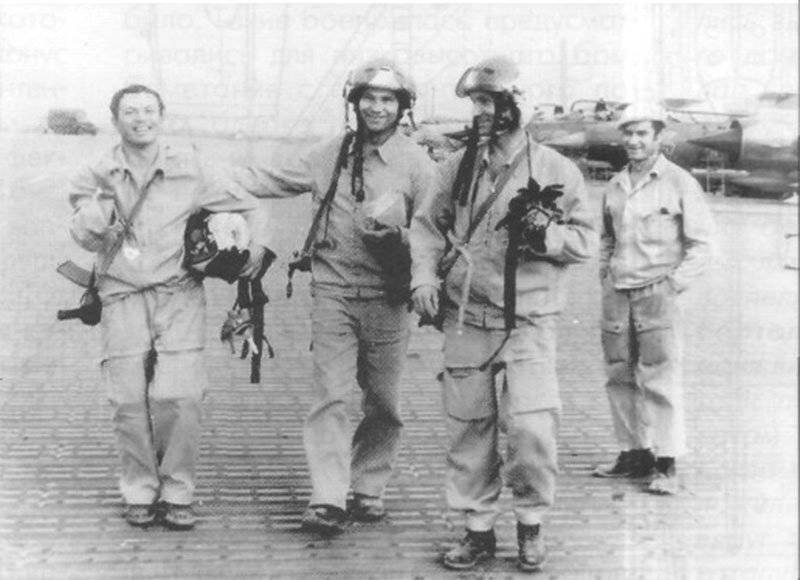
MiG-21 Alexei Gordiyuk was the last car of this type, lost in Afghanistan exactly one month before the regiment returned to the Soviet Union. They were replaced by the MiG-23, however, some of the twenty-first who had fought back were still in Afghanistan — when parts were transferred to the house they were handed over to Afghans to compensate for the large loss of technology in government aviation.
In addition to the MiG-21 fighter aircraft, the 40 Army's air force included reconnaissance aircraft MiG-21Р, which served in the 263 separate tactical reconnaissance squadron. When the troops entered, this part was not yet formed, and one of the squadrons of the 87 reconnaissance regiment from Karshi in Uzbekistan with a dozen aircraft was sent to Afghanistan. The scouts were based in Bagram. Subsequently, 263-I reconnaissance squadron was completed shifts from different parts of the country. The task of the scouts was assigned:
- Opening of the areas of concentration of the rebels and the direction of movement of opposition units;
- control of the condition of roads on the routes of movement of troops;
- targeting of aviation strike groups;
- photo control of impact results;
- striking open objects with the use of on-board weapons.
To fix the consequences of the attack, not relying solely on the emotional reports of the pilots, was required for obvious reasons - a revived machine-gun nest or a surviving stronghold could cause serious trouble and lead to unnecessary casualties, and even jeopardize the further performance of the troops. For day and night photography of the terrain, MiG-21Р were used, equipped with overhead containers with a set of reconnaissance equipment. For night shooting cameras were used with lighting cartridges. The reconnaissance was also carried out using a set of television equipment that transmitted the image of the area being filmed to a ground control station, which ensured the visibility and efficiency of the transmitted information. The equipment of the MiG-21Р also included a tape recorder, on which the pilot wrote down "travel impressions" of the objects observed, their location and noticeable landmarks. During the first year of the war, reconnaissance squadrons completed more than 2700 sorties (on average, 156 sorties per crew).
In addition to departures for aerial photography, the MiG-21Р were involved in radio intelligence. It was carried out by means of the equipment of a special suspended intelligence container, which fixed the location and characteristics of the radio-emitting means. The task was to uncover the state of Pakistan’s air defense system in the areas adjacent to the border, from where opposition from its neighbors could be expected. From January to December, 1980 of the year were carried out over 600 of radio reconnaissance missions, as a result of which radars were detected in a number of areas of Pakistan, at its aerodromes and air defense installations.
The reconnaissance MiGs were used during night strikes, highlighting the area of the raid with “chandeliers” - the SAB-100 and SAB-250 lighting bombs. They took part in attacks and searching for caravans with weapons, especially at night, since the scouts were among the few who were entrusted with risky night work in the mountains (if during the day search groups were searched by helicopters, then the caravan was obviously not carrying raisins, and fate was decided unequivocally). The crews of the MiG-21Р, who knew better than anyone else where to look for the target, conducted a “free hunt” - an independent search and destruction of the enemy. In this case, they carried outboard tanks, two RBC-250-275 or two to four large-caliber C-24 missiles. On the MiG-21Р squadron flew until the spring of 1984, when the "twenty first" in its composition changed the new Su-17М3Р.
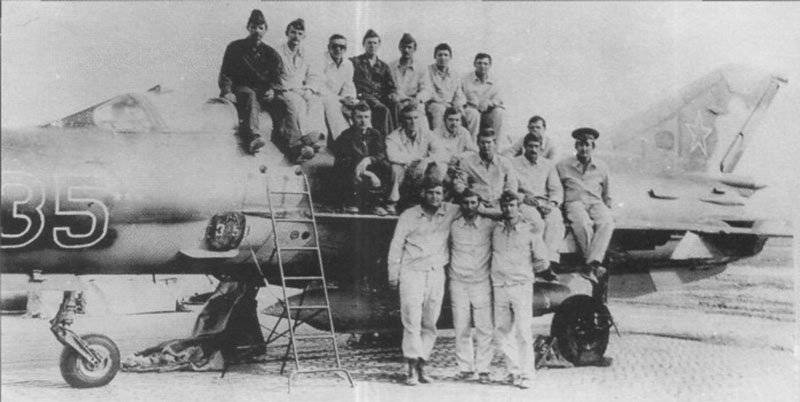
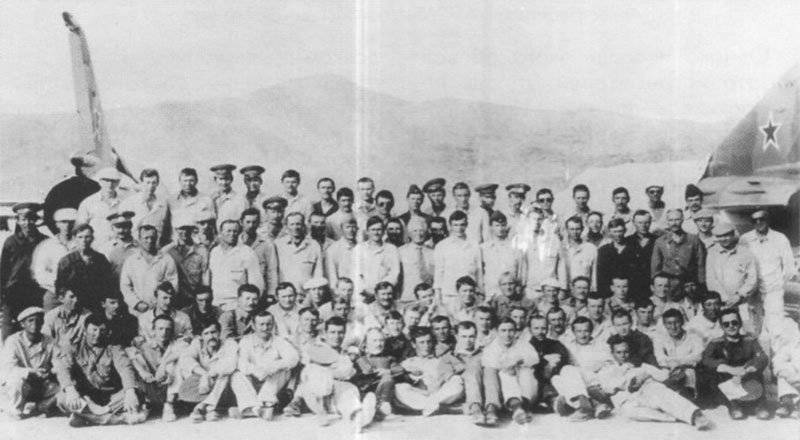
Since the summer of the 1984, the MiG-21 in the 40 Army Aviation has been replaced by more modern MiG-23 fighters. However, after that the honored plane was not dismissed and the participation of the “twenty first” in the Afghan campaign continued. 115 th guv. IAP continued to fly MiG-21bis to the very end of the Afghan war, periodically engaging in support of hostilities in northern Afghanistan from its own airfield. The regiment by this time counted in three 32 squadrons of combat MiG-21bis and eight "Sparks" MiG-21UM, representing the real force, which was literally at hand. Kokayts were located much closer to the location of operations than the airfields of the 40 Army’s air force, and the border provinces “on the other side” were very familiar to the pilots who worked in these parts from year to year. The main areas where it was necessary to make combat missions were located in Mazar-i-Sharif, Kunduz, Talukan, Pul-i-Khumri and Faizabad. In normal cases, MiGs could appear in the right place literally in a matter of minutes, however, some departures had to be carried out at the limit of reach using the PTB-800 under-body suspension tank.
The last military operation with the participation of the MiG-21 from Kokaita was Ramitskaya, conducted by the troops in the area of the same gorge in the Aybak-Puli-Khumri region in March 1988. Subsequently, with the commencement of the withdrawal, the combat operations of the ground units were minimized to reduce losses and were carried out only to deter the enemy.
However, after that, the combat work of the fighters did not stop at all: the pilots of the 115 regiment continued to carry out missions to familiar areas, pursuing the tasks of "psychological influence" and demonstrating their readiness to thwart any attempts of active actions by the enemy. The raids were carried out according to intelligence data with bombing of dushmansk camps in the mountains and strong points in the villages. The then commander of 115-iap Colonel ON Strukov, on whose account 140 had been flying sorties from his aerodrome, intelligibly characterized the following tasks: “To keep spirits” in a black body and not to give heads up ”. Once or twice a week, bombing was carried out on the targets. Closer to the date of the complete withdrawal of the troops, the intensity of combat work increased: places adjacent to the paths along which the departing columns stretched were bombarded. In the fall and winter months of the 1988-89 of the year, right up to mid-February, the pilots had to fly three or four flights a day. Combat charging of the MiG-21bis amounted to two bombs caliber 500 kg or four 250 kg per aircraft. Types of ammunition were determined by the combat mission, from high-explosive, high-explosive, incendiary and RBC when striking settlements and bases of insurgents to concrete-breaking and volume-detonating bombs to defeat mountain shelters, fortifications and protected targets.
Since the enemy already possessed modern means of destruction, including MANPADS, appropriate security measures were taken. Radio interception was not ruled out, which was not at all an exaggeration: sometimes it was necessary to hear negotiation of deceivers at working frequencies. The teams on the air could give the approach of the strike group and become a warning to the enemy. Radio transmission was minimized, doing a couple of phrases when entering the train and beginning the attack; all the rest of the time in the air was carried out in radio silence mode. Another essential measure performed by the attack was the construction of attacks: the introduction into a dive, usually quite steep to increase the accuracy of bombing, was carried out from a height of 8000 m, in ten seconds it was necessary to have time to make aiming and bombing. The bombs were dropped from a height of the order of 5500 m, so that at the output the height was at least 3000 m, beyond the reach of the anti-aircraft guns of dushmans. The thoughtful construction of the attacks made it possible to avoid defeat and combat damage. Getting into a fast-moving plane on a steep trajectory was almost impossible.
During the entire period of participation in the fighting, the regiment made almost 5000 combat missions. 151 man from the unit was awarded orders and medals. In the winter of 1989, the 115 of the Guards. IAP switched to the latest MiG-29 fighters.
115 th guv. Iap was the only one in all front-line aviation that was awarded a combat reward for participation in the Afghan campaign - the 11 of March of 1981 was awarded the Order of the Red Banner.
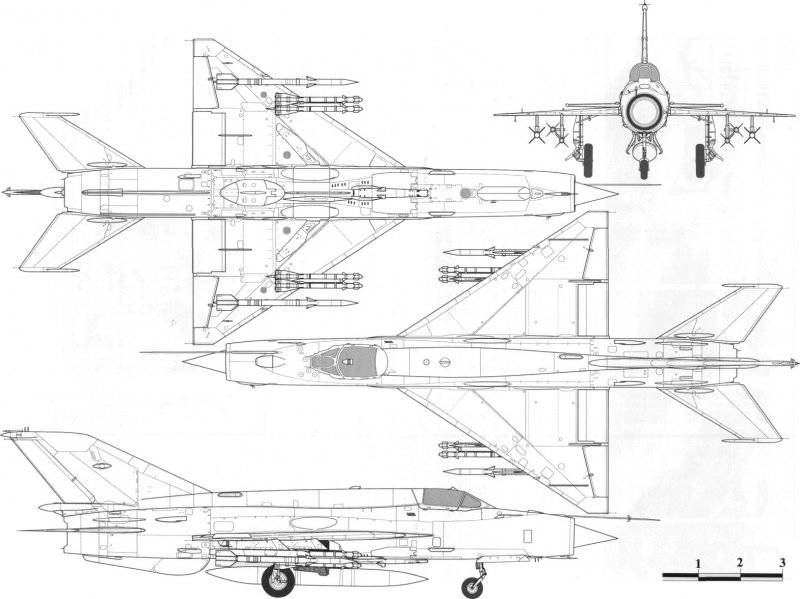
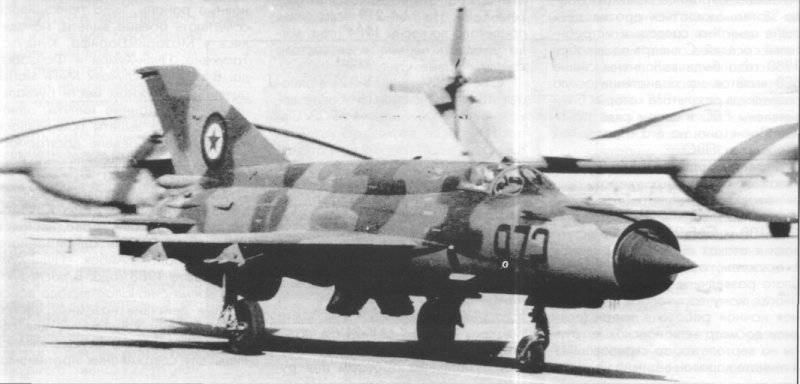



Information